

AAAFDGFDS
Community Led Landscape Management Project (CLLMP)
The Government of Meghalaya with financial help from the World Bank is implementing the Meghalaya Community Led Landscape Management Project (MCLLMP). The project will cover the entire state of Meghalaya and implementation of community led plans will be rolled out in phase manner throughout the state. The Meghalaya Basin Management Agency (MBMA) will facilitate community-led planning by providing support, technical inputs and funding.
The Project is intended to strengthen community-led natural resources management in selected landscapes within the 7 districts of the state. This would be achieved through a variety of planning, capacity building, and on-the-ground interventions to promote the conservation, sustainable use of natural resources, social inclusion and community mobilisation; building traditional knowledge and learning, mapping of natural resources management; strengthening the community institutions and creating linkage with financial institutions and community organizations.
The project interventions include preparation of community led natural resource management plans. The CLLMP has the following three components:
1.Strengthening Knowledge and Capacity of Communities for Natural Resources Management
2.Community-Led Landscape Planning and Implementation
3.Project Management and Governance
The project objective is “to manage and conserve the natural resources, especially forests, soil and water sources, in a manner that supports the financial and physical well-being of communities in the State”
Introduction
Mynnar Jirang Village falls under Jirang C&RD block of Ri-Bhoi district in the state of Meghalaya. The village is at a distance of 70 Kms from Nongpoh, the district headquarters of Ri Bhoi District and is at a total distance of 123 Kms from the state capital, Shillong. It falls under Raid Jirang with a total geographical area of 1551.48 ha and a total population of 697 villagers.
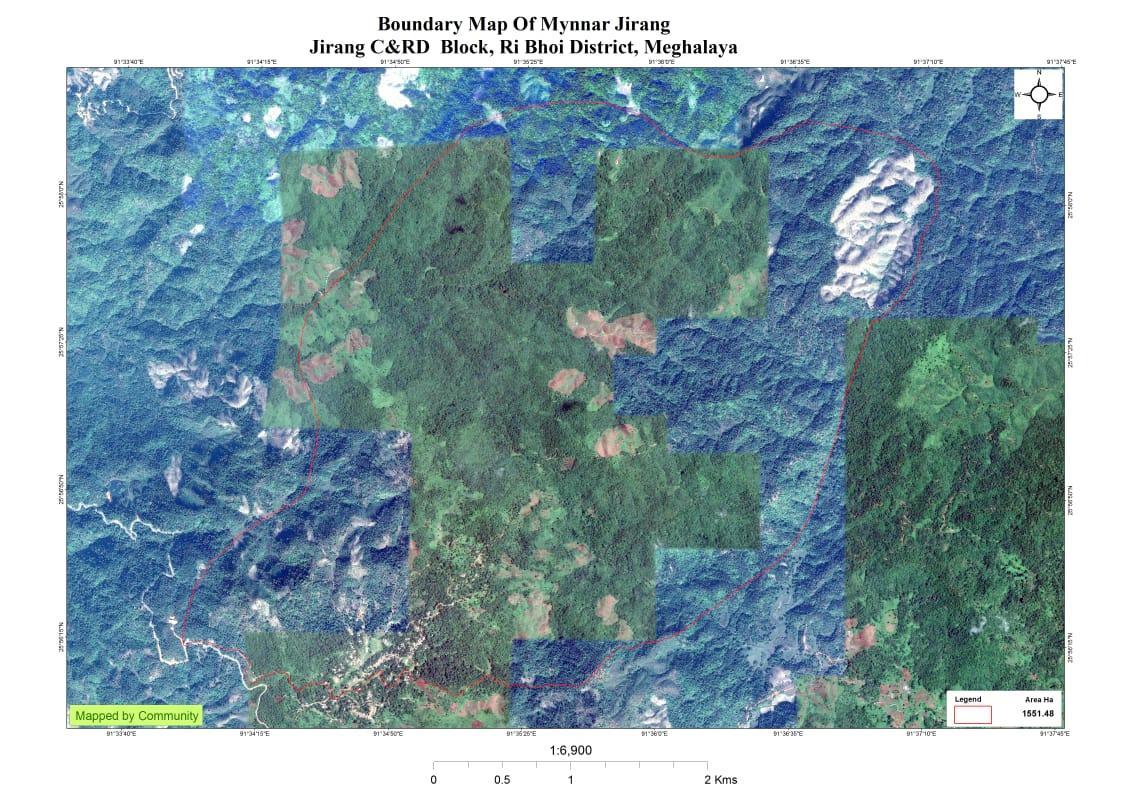
Short History of Mynnar Jirang
Mynnar Jirang village has been around for a very long time. Its estimated time of foundation was around 1740-45. In the year 1844 an Englishman named Jacob Tomliu of Mission Survey of India came to this village, and when he saw a man smoking a pipe and he asked the man for the name of the village and the man said “Charang” cause he did not understand what the Englishman was saying and that’s how the Englishman wrote the name of this village as Jirang. Thomas Jones after celebrating Christmas at Mawdem village came to this village on the 26th of December 1870 and on the 27th December he preached the Gospel in this village and the sermon was so touching that King Saduh Kuia converted and made an announcement for the villagers to come to a sermon organized by Thomas Jones. Thomas Jones while reading the writings of Jacob Tomliu found that the name of the village was written as Jirang and the inhabitants are of Mynnar tribe and since then the village was named as Mynnar Jirang.
During that time the number of households in the village were around 40-45 but it grew at a very fast pace that by the year 1960 the village was the largest and most populated village in the whole Western Ri-Bhoi. A fire broke out on the 16th of April 1976 at Mynnar Jirang and after this the name New Jirang came up. Mynnar Jirang is divided into 8 different localities, Nongtharai, Nongkynlai, Dongkani, Nongkyntu, Nongkdait, Sngitin, Amkrew and Dongkhawar.
The village is run by the Headman (Sirdar) along with the secretary and 16-17 executive members who are elected by the Village Durbar. The village durbar is held two to three times a year. The village has a Jirang State Dispensary, an Upper Primary School, a Government Lower primary SSA School, an ICDS Centre (Anganwadi), an Asha and a church. The village also has 12 drinking water springs that are used till date. Most of the villagers practice cultivation (Jhum) and they cultivate betel nut, fruits, rice, pumpkin, ginger, banana and others. They also rear cattle, pigs, poultry and oxen. Some of the villagers are carpenters. Most of the villagers are still economically lacking.
The villagers used to barter pumpkin, papaya, and yam for rice with the people of Assam. They are also adept at weaving baskets and many other materials from bamboo. The villagers are also very united and willing to participate if any organization or government department organizes any kind of training.
Social Profile
The total number of households is 118 and has a population of 707 people. Most of the people are engaged in Agriculture allied activities , Masons, Local vendors and where some few others are also enrolled in government servants .
Village Accessibility: In order to reach Mynnar Jirang village, one must venture through the Umling P.W.D. road laying 15 km from the Block Headquarter and lying 95 KM far away from District Headquarter one who wants to venture Mynnar Jirang village it’s very easy to find Mynnar Jirang village they can venture from Assam Rani road then to the left one Road that will take you inside the village all the road inside village are well constructed and it’s easy to round the village .
Literacy: As per the 2011 census, the village literacy rate has touched to the tune of 85.75 in which it is higher compared to Meghalaya literacy rate 74.43% as of 2011 Census the Male literacy rate of Mynnar Jirang village stands at 86.40% while female literacy rate was 85.05% .

Population
As per Census 2011, Mynnar Jirang's population is 707 . This village has 66 children in the age group of 0-4 years. Among them 32 belong to boys and 34 are girls.
| Age Group | Male | Female | Total |
|---|---|---|---|
| 0-4 | 32 | 34 | 66 |
| 5-14 | 120 | 133 | 253 |
| 15-30 | 100 | 104 | 204 |
| 30-60 | 60 | 65 | 125 |
| Above 60 | 32 | 27 | 59 |
BPL/APL Household:
The village has a total number of 118 Ration cardholders in which 115 belong to BPL and 03 belong to APL. The major occupation of the people is farming while some are Teachers , Mason and Govt. servants.
| Total HH | 181 |
|---|---|
| BPL | 115 |
| APL | 03 |
Card Holding Household:
| Particulars | No. of HH |
|---|---|
| Total HH | 118 |
| Ration Card HH | 115 |
| Health Card HH | NIL |
Fuel Type:
| Fuel Type | Total HH |
|---|---|
| Charcoal | NIL |
| Biomass | NIL |
| Wood | 118 |
| LPG | 28 |
| Electric Heater | NIL |
| Kerosene | NIL |

OCCUPATION: The people of the village rely on agriculture and forest products for their livelihood. The main occupation of the Community is farming followed by Teachers , Masons and Carpenters , some other Government Servants.
Drinking Water: The village has access to
Government water supply through pipelines in different localities
and they face problems sometimes only during rainy and dry season.
In the rainy season the water becomes red and full of mud but during
the dry season not enough water Tank for the whole village.
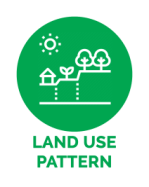
Jhum cultivation: mainly take up traditional approaches of cultivation like Jhum or the shifting cultivation
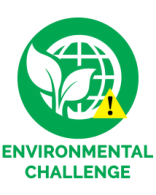
WATER BODIES LAND
Spring – 7 Forest Area-1289.07 Ha
Stream – 4 Cultivable land- 2.83 Ha
Pond – 6
Ground Truthing
Dated: 4th of July 2019
The CLLMP team met with Mr. Wellborn Syiem, headman of Mynnar Jirang village on the 4th of July 2019. He provided the team with important information regarding the current scenario of the landscape and the natural resource management under his chairmanship.

Case Findings:
There are a total of 118 Households out of which 115 HH falls under the BPL category
Actively performing VEC
Around 18 acres of farmland have been left un-irrigated due to water problems
They have four source of drinking water
They have four streams
Presence of waste lands and degraded lands
Around 40 acres of cleared forests in the past years
Sensitization Programme
Dated: 22nd of June 2019
The District Project Manager and the Assistant Managers held a village Level sensitization Programme on the Community Led Landscape Management project on the 22nd of June 2019.The villagers actively participated in the program, voicing out their concerns and questions regarding the project making it a huge success.
The CLLMP officials gave a brief introduction on Meghalaya Basin
Management Agency (MBMA) and elucidated about the various programmes
and projects that MBMA is working on, they then gave a detailed
introduction on the Community led Landscape Management Project
(CLLMP) and the different aspects and procedures that the villagers
and the CLLMP team should carry out during the course of the project
and the importance of the involvement of the community for the
CLLM-Project to be a success. They gave due importance to the
environmental aspects of the project and enlightened them on the
various benefits that the villagers could obtain from the
project.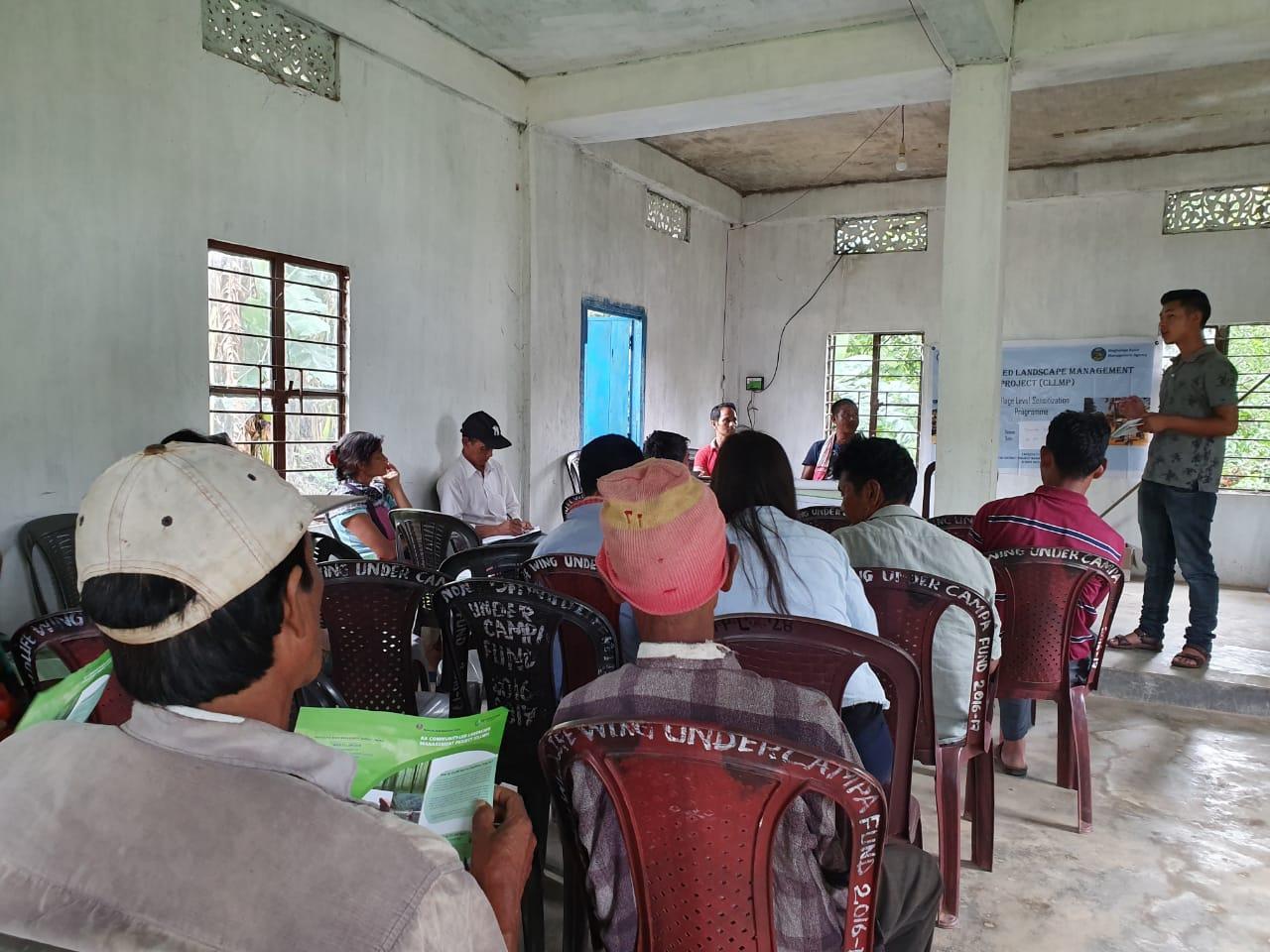
The Program was followed by an interactive session to answer the doubts and questions of the villagers.
2.2 Signing of Documents:
After the interactive session, the village signed the Expression
of Interest (EOI), the Village Grant Agreement (VGA) and the
Citizen’s Green charter on the same day.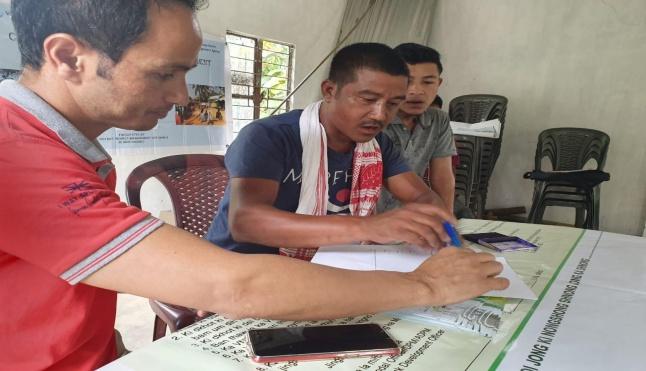

2.3 Formation of the VNRMC
The Formation of the Village Natural Resource Management Committee was done in a public meeting in the presence of the entire village and the CLLMP staffs. The community itself chose the President, the Secretary and the other executive members of the Committee.
Listed below are the members of the VNRMC:
|
|||||||||
|---|---|---|---|---|---|---|---|---|---|
|
Name | Designation | Gender M/F | Age (Yrs) | Education | Occupation | Community | Religion | Contact No |
|
Wellbin Syiem | Chairman | M | 43 | VIII | Business | Khasi | Christian | NA |
|
Wisedom Nongkyndah | Secretary | F | 45 | VI | Farmer | Khasi | Christian | NA |
|
Ophral Thangkiew | Bookkeeper | M | 62 | VIII | Farmer | Khasi | Christian | 986472280 |
|
Arbanshan Jamu | Member | M | 49 | VIII | Farmer | Khasi | Christian | NA |
|
Esekiel Lapang | Member | M | 31 | XI | Farmer | Khasi | Christian | 8730910713 |
|
Erina Mawblei | Member | F | 33 | VIII | Farmer | Khasi | Christian | 8413989387 |
|
Lawborn Lapang | Member | M | 28 | BA | Farmer | Khasi | Christian | 9383051281 |
| Orsholin Mawblei | Member | F | 26 | BA | Farmer | Khasi | Christian | 8132009656 | |
| Dondor Syiem | Member | M | 29 | BA | Farmer | Khasi | Christian | 9615836576 | |
| Village Community Facilitators | |||||
|---|---|---|---|---|---|
| Name | Gender | Age | Education | Contact Number | Role |
| Lawborn Lapang | M | 28 | BA | 9383051281 | Environment Management |
| Sepiarlin Syiem | F | 26 | BA | 8132009656 | Knowledge Management |
| Dondor Syiem | M | 29 | BA | 9615836576 | Social Management |
Purchase Committee |
|||
|---|---|---|---|
| Sl.No. | Name | Gender | Contact Number |
| 1 | Arbanshan Jamu | M | NA |
| 2 | Eskiel Lapang | M | 8730910713 |
| 3 | Erina Mawblei | F | NA |
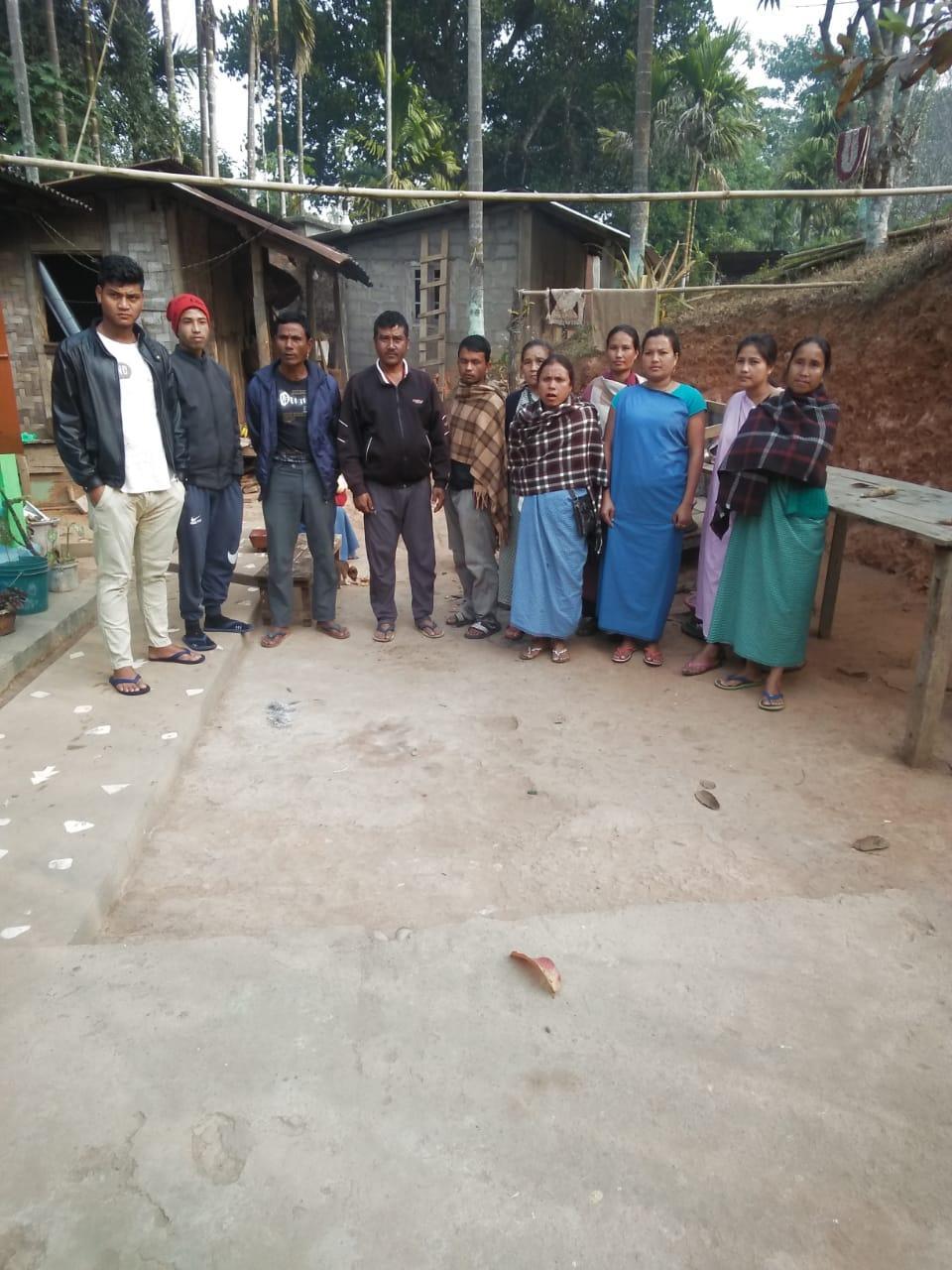
Figure : The Village Natural Resource Management Committee

Figure : The village Community Facilitator
3. Opening of a Bank Account.
The opening of the bank account was initiated after the village signed the EOI (Expression of Interest), the VGA (Village Grant Agreement) and the Green Charter. The Accountant of the Ri Bhoi CLLMP team trained the Purchasing and Procurement Committee of Jirang Block including members from Belahari Village on matters relating to Accounts and Bookkeeping on the 16th of September 2019.
Training on Accounts and Book-Keeping
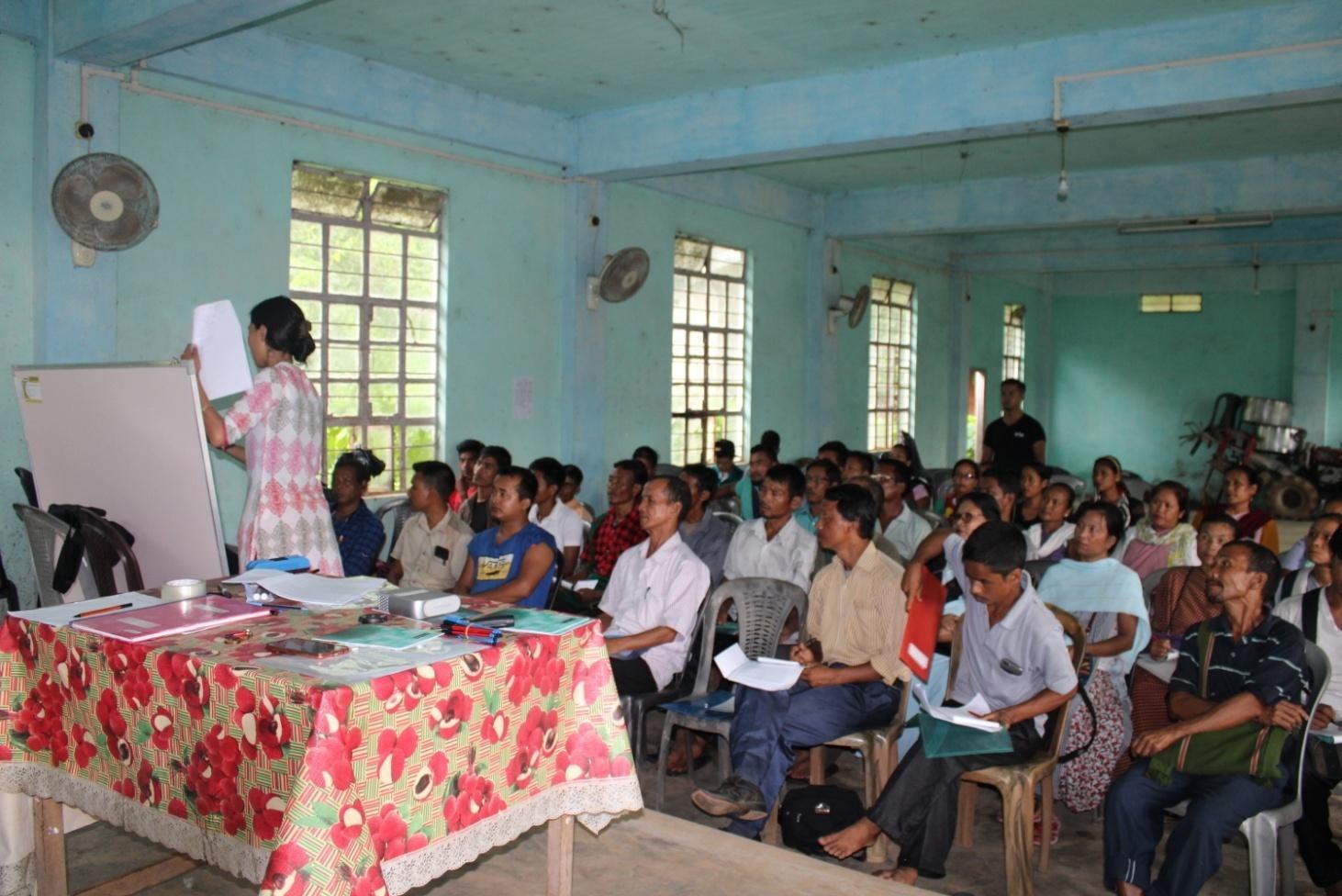

PRA Exercise
The PRA exercise aims to incorporate the knowledge and opinions of the community in the planning and management of development projects and programmes. PRA exercise at Mynnar Jirang Village took place on the 28th of August 2019. There were a total of 85 villagers who participated in this exercise
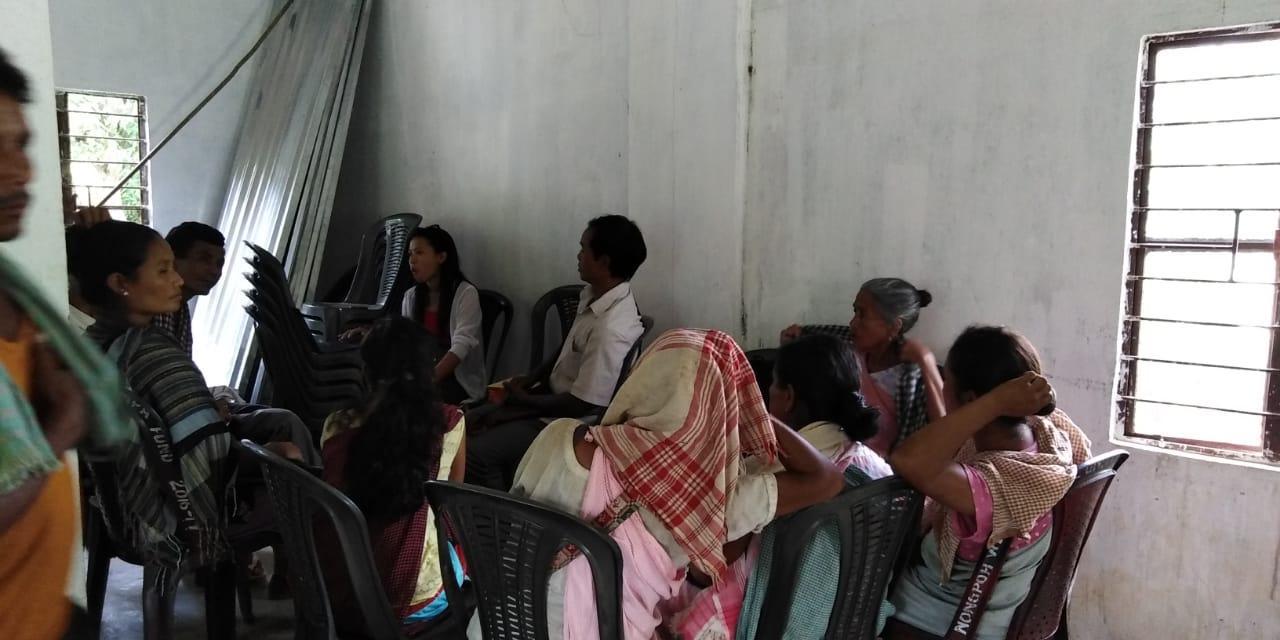
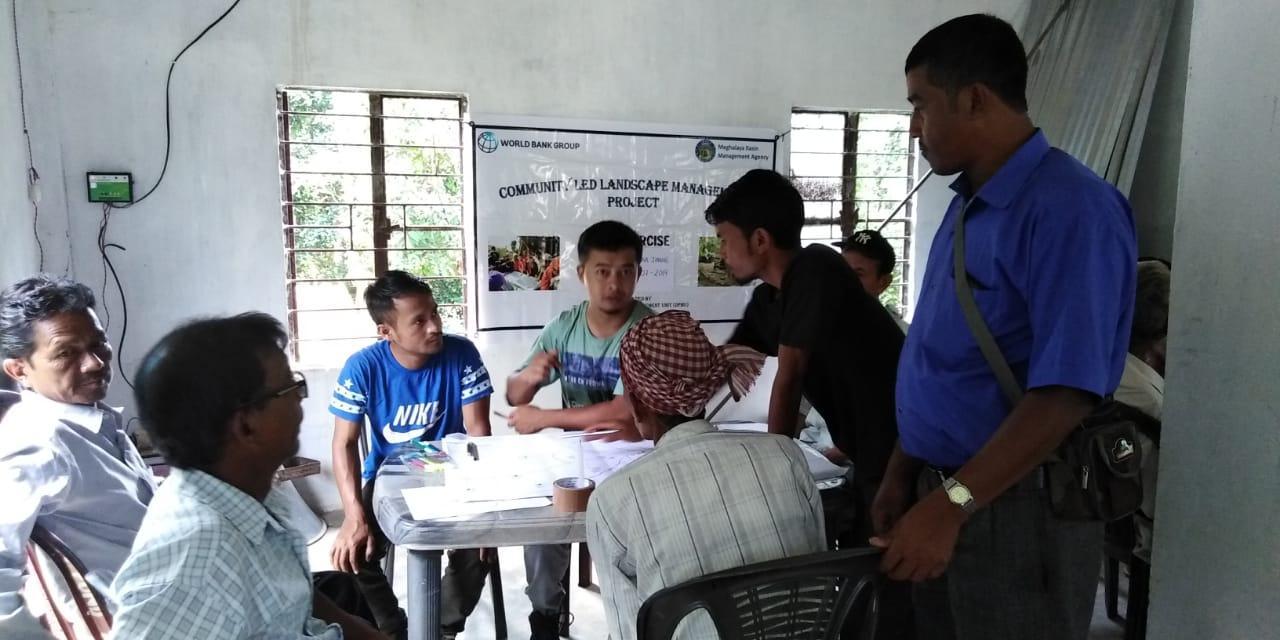
Activity 1: Drawing of Resource
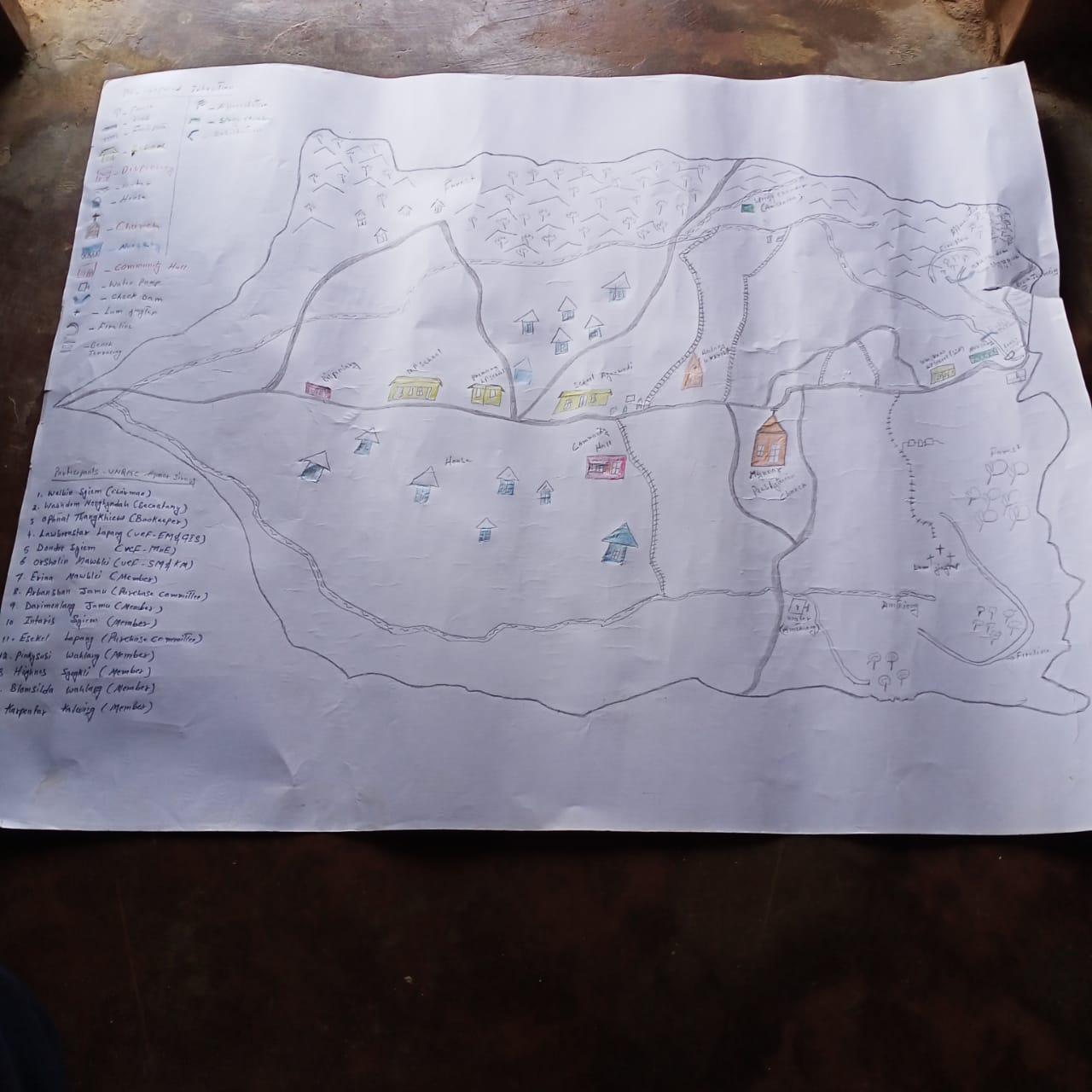
Findings Based on the Resource Map of Mynnar Jirang Village:
Main agricultural crops are Paddy, Banana and Ginger.
There are 2 types of Forest ownership: Community, Private
i) 4 community forest
ii) 3 private forest
Fours streams that provide water for drinking and washing purposes in the village.
Seven streams are present in the village boundary.
There are 6 fisheries ponds.
School
Church
Roads and footpaths are well connected within the village
Activity 2: Baseline Data Survey to fill the Social and Environment Template
During the PRA Exercise the EE SM and with the community sit together to have a brief discussion on the problems and challenges face by the women in the village and also Discussions and consultations with social groups existing in the village was held to gather basic village information regarding no. of households, demographic information, major crops and enterprises taken in the village, trends of production and productivity of major crops in the village and demographic distribution of village population and also group discussion on problems and challenges faced by the community in the village.
Activity 3: Problem Analysis
A. Do people have sufficient access to supply of fodder ,fuel wood, leaf litter?
yes, till dates they access sufficiently to fodder, fuel wood, leaf litter from their community forest (khlaw ,shnong, raid )
B. Has access to timber improved or reduced over the years? How is access for household use and commercial use managed?
As compared to other years it has been reduced but they still managed for household and commercial use .
C. Are the Water bodies facing any threats?
No threats, but during the rainy season all the water bodies become red, full of mud and difficult to access for drinking, cleaning and washing.
D. Do all the people in the village have access to drinking water? What are the challenges?
The village is divided into 9 Hamlets Umjiong, Nongkyntun, Nongkharai, Nongkyllai, Tyrllaw ,Amkrem, Sngitin, Nongkdait, Smowkoki all the 9 Hamlets have access to drinking water through Tap water from PHE and comparatively Umjiong, Amkrem and Nongkdait they access through Check Dam. Only during the Dry season they face water scarcity that is from the month of march-may.
E. Are there degraded areas in the village (open/degraded forests , mining affected ,high soil erosion etc)?
None.
F. What has caused this degradation ? Are there practices causing threats to availability and access to natural resources ?
None.
What have been the changes in agricultural practices?
They are still practicing Jhum Cultivation with no other changes but people after paddy harvesting are engaged in crop cultivation.
Are there any challenges in farming?
Yes they face a lot of challenges especially wild animals they come and destroy all their paddy fields and also they eat and damage the crops and everything.
How would you consider the health situation in your village?
According to the village report the infant age group and eldest group compared to the years before there were cases with Diarrhoea and Malaria but as of now there are no cases of Malaria and other sickness and the health situation has been improved.
The ASHA plays their vital role in examining and monitoring the daily food supplements in the village and they are the assistance workers for the pregnant women and children under 6 years below.
How is the situation of cleanliness , sanitation access to toilets and waste management ?
Cleanliness in the village has been improved as compared to others years after the Swachh Bharat Mission came into force. Under this Mission in 2007, 82 Households in the village got the sanitary latrine through NBA scheme the cleanliness is the priority of the village. Awareness programmes are conducted within the village.
Who is the most vulnerable group in the village? What can be done to improve their lives?
BPL Families . Inclusion of BPL Families during project implementation.
What are the livelihood aspirations of the youth ? Are there any avenues available?
The majority of the people in the village turn to farming and get a job card under MGNREGA for employment.
Do any committees /institutes/rules exist to manage and monitor natural resources in the village?
The VNRMC under the CLLMP will manage the Natural resources in the village . prior to the CLLMP the village received permission from the forest management committee to look after and preserve the forest. There are two community forests Amdhi and Amphung in which Amdhi has 200 Acre and Amphung 81 Ha.
What are some of the major issues or conflicts in the village?
Till date the people of the village have no dispute or issues within or outside the village they live in a peaceful environment.
Have any of the above issues been discussed in village meetings?
If there is any issues or conflict within the village the Durbar shnong will solve the issues and address the Problems
How do people resolve disagreements and conflicts?
All disagreements and conflicts are addressed by the traditional institution of village governance called the village Durbar.
Activity 5: Seasonal Calendar
The EE Social Management also mapped the seasonal calendar of Mynnar Jirang Village to help identify heavy workload periods, periods of relative ease, credit crunch, diseases, food security, wage availability , festive season etc. This will prove helpful in project planning and project timeline framing.
Participants:
Shri Ophral Thangkiew - VNRMC Member
Smt Orsholin Mawblei -Village Community Facilitator
Smt Erina Mawblei - Purchase Member
Smt Bluesky Jamu -Community Member
Shri Lawborn Lapang - Village Community Facilitator
| SEASONAL CALENDAR | |||||||||||||
|---|---|---|---|---|---|---|---|---|---|---|---|---|---|
| Sl No. | CRITERIA | JAN | FEB | MAR | APRL | MAY | JUNE | JULY | AUG | SEP | OCT | NOV | DEC |
| 1 | Water Scarcity | 2 | 1 | 1 | 1 | 3 | 3 | 3 | 3 | ||||
| 2 | Prone to sickness | 3 | 1 | 1 | 1 | 1 | 2 | 2 | 3 | ||||
| 3 | Seeking job outside | 2 | 2 | 3 | 3 | 1 | 1 | 1 | 1 | ||||
| 4 | Rain Fall | 2 | 1 | 1 | 2 | 2 | 3 | ||||||
| 5 | Free – Less work | 3 | 3 | 2 | 2 | 1 | 1 | 1 | 1 | 2 | |||
| 6 | Paddy Cultivation | 1 | 1 | 1 | 2 | ||||||||
| 7 | Paddy harvesting | 2 | 1 | 1 | |||||||||
| 8 | Ginger cultivation | 1 | 1 | 3 | 3 | ||||||||
| 9 | Ginger harvesting | 1 | 1 | ||||||||||
| 10 | Tree Plantation | 3 | 3 | 1 | 1 | 1 | 2 | ||||||
| 11 | Vegetable (crop cultivation) | 1 | 1 | 3 | 11 | ||||||||
| 12 | Vegetable (crop harvesting) | 1 | 1 | ||||||||||
| 13 | Festive Season | 1 | 1 | ||||||||||
| 14 | Forest fire | 2 | 1 | 1 | 3 | 3 | 3 | ||||||
| 15 | Collection of Fuel wood | 3 | 3 | 2 | 1 | 1 | 1 | ||||||
| MAXIMUM | 1 |
|---|---|
| MODERATE | 2 |
| LESS | 3 |
5. Training on the Development of the Community Natural Resource Management Plan (CNRMP)
With the completion of the Participatory Rural Appraisal (PRA) Exercise, a joint training to help the VNRMCs of Jirang Block develop their Community Natural Resource Management Plan or CNRMP was organized on the 16th of September 2019 at the Community Hall of Patharkhmah Village.
Members of the VNRMC from Mynnar Jirang Village were also present
for the training.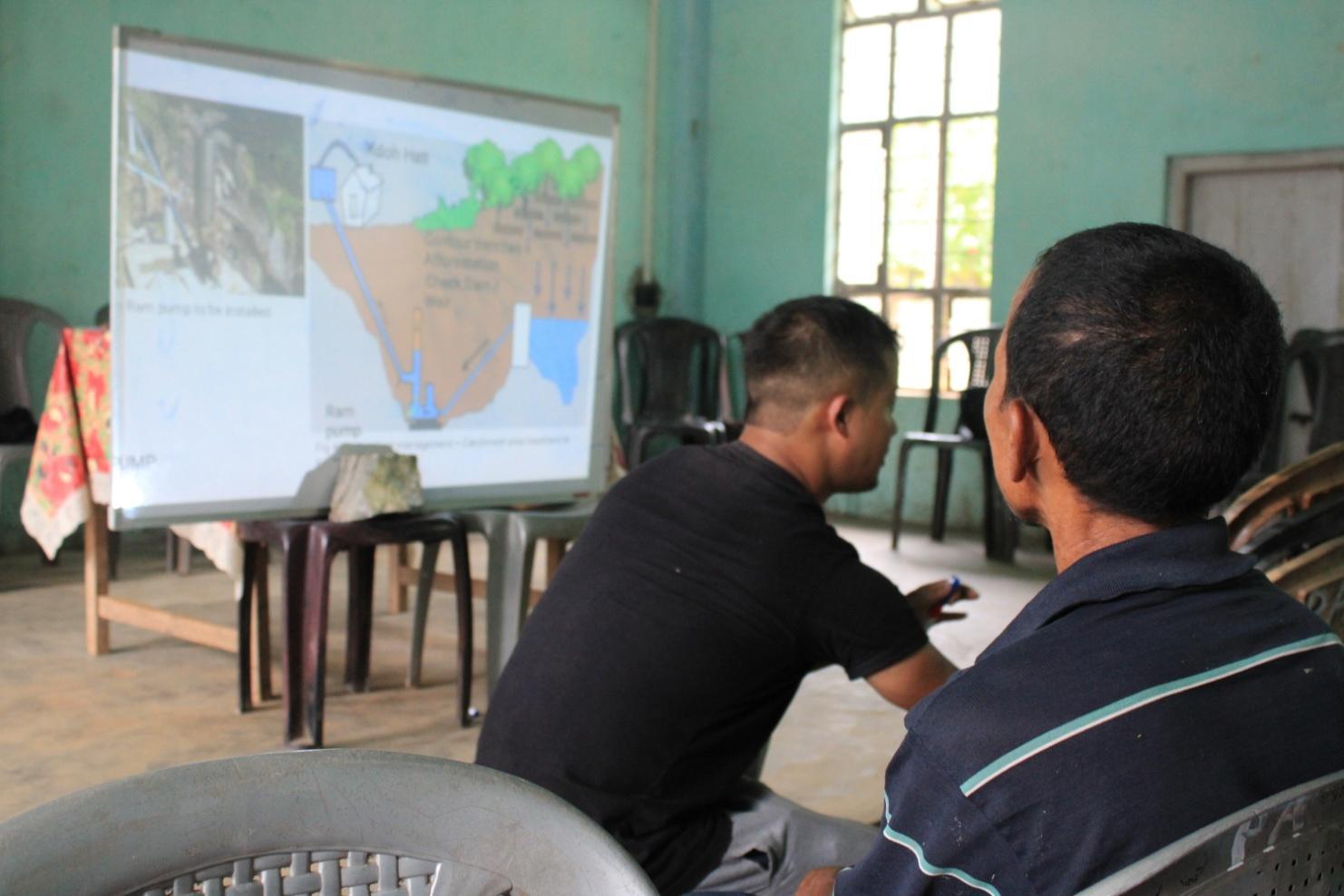
Mr. Reuben Shabong, Assistant Manager (Environment Management) giving a presentation on CNRMP
Mr. Reuben Shabong , Assistant Manager for Environment Management discussed the different types of plans that can be adopted by the villages and stressed on the need for more holistic and sustainable plans which will benefit the community as a whole.
Activity 6: Baseline Data Survey to fill the Environment Template
During the PRA exercise External Expert of Environment Management discussed information related to land use categories such as forest, cultivable land, water bodies ,etc. with a group consisting of village community members who are quite aware of the village boundary and the presence of natural resources in the village.
Problems and challenges related to NRM were discussed. The village population faces a lot of destruction from forest fires during the dry season. Much of their crop and fields are engulfed and destroyed by the fire. Though some regulations are given by the VEC, there are no strict laws to prevent this yet. Drinking water is sacred during the dry seasons and family members have to collect from two or three only sources of water during the dry season. Deforestation and Jhum cultivation are increasing day by day and soil fertility is lost with each year. The various problems are voice out by the community members during the exercise. The NRM that can be done in the village are discussed.
Fig: EE EM with community Members and VNRMC
Members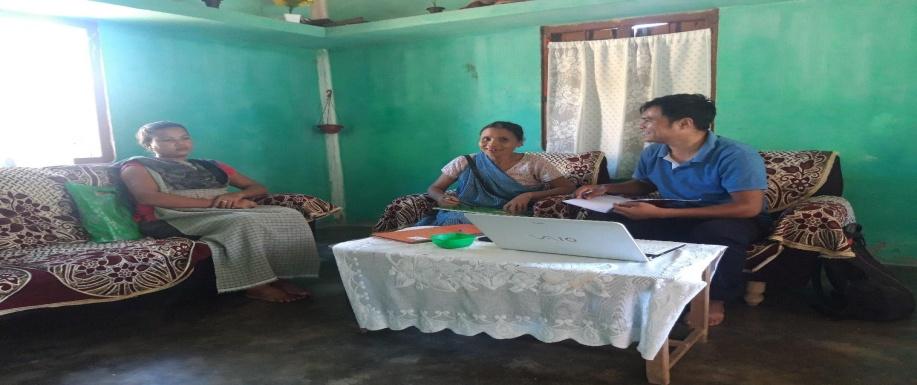
Participants:
Wellbin Syiem - Chairman
Wisedom Nongkyndah- Secretary
Ophral Thangkiew- Bookeeper
Lawborn Lapang - VCF
Orsholin Thangkiew- VCF
Dondor Syiem- VCF
Arbanshan Jamu- Purchase Member
Eskiel Lapang- Purchase Member
Submission of the List of NRM activities proposed by the VNRMC.
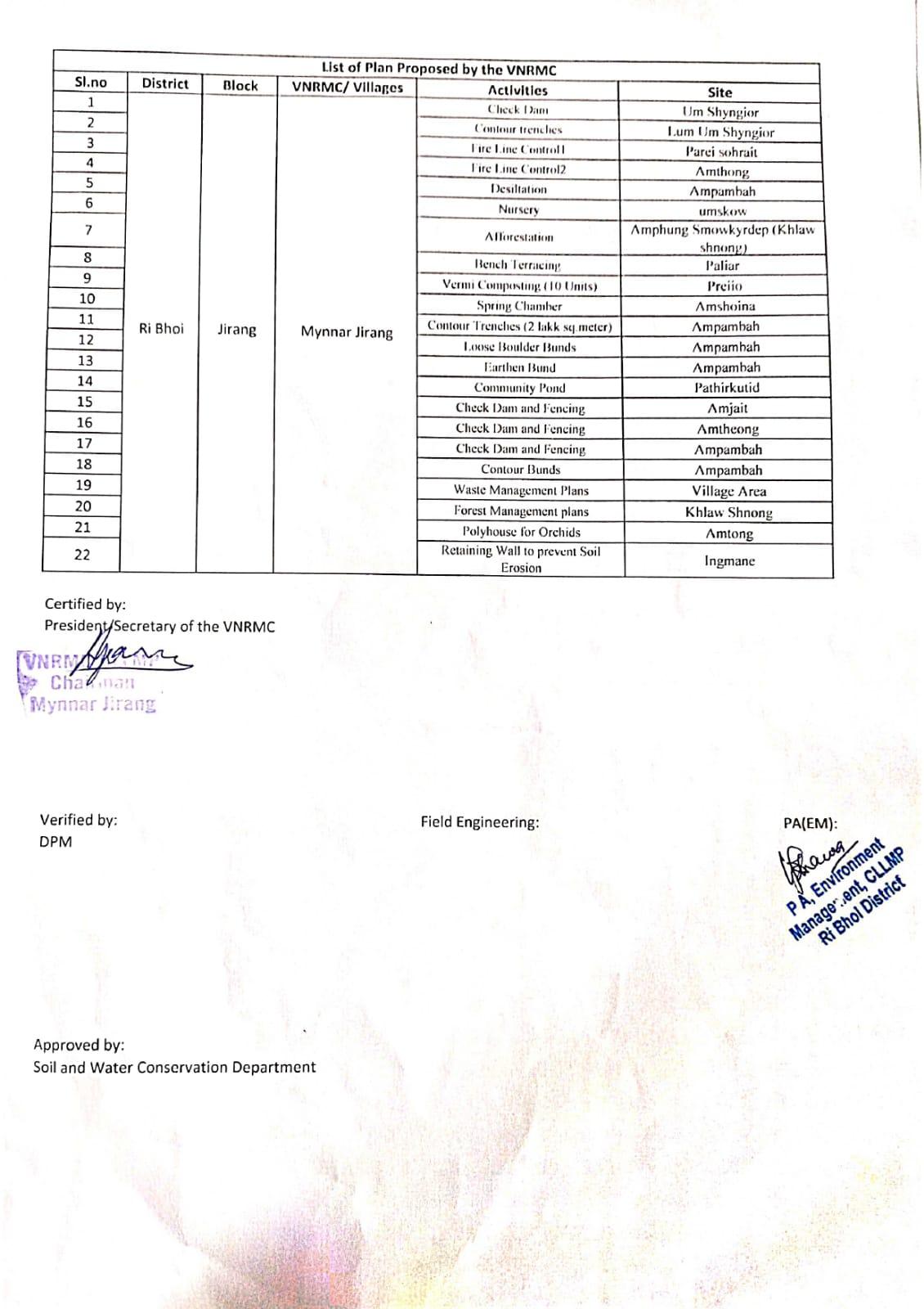
Final List of Plan prepare by Mynnar Jirang VNRMC
| Area of Intervention | Intervention 1 | Intervention 2 |
|
Intervention 4 | Intervention 5 | Remark on any traditional knowledge/ best practice within the village |
|---|---|---|---|---|---|---|
|
|
|
|
|
||
| Soil and Water Conservation | Checkdam
2. Amjait 3.Amtheong 4.Ampambah) |
Counter Trench (UmShangyiur) |
|
|||
| Land Productivity Enhancement | Bench Terracing (Palir) |
Vermi Compost (Preiio |
|
|||
| Spring Shed Management |
|
|||||
| Afforestation/ Community Forestry Activities | Nursery (Amtong) |
Afforestation (Amphung , Smowkyrdep) |
||||
| Forest area under management plans |
|
|||||
| Enhancement of Agro-forestry Activities | ||||||
| Culturable waste land brought under Horticulture | ||||||
| Activities to Treat Mining Affected Area | ||||||
| Others |
|
|
Poly House for Orchid (Amtong) |
GIS Activities – MYNNAR JIRANG
| Sl.No | Parameters | Village Information |
|---|---|---|
| 1. | GPS Coordinates | |
| i | Latitude | 25.936172N |
| ii | Longitude | 91.580237E |
| iii | Elevation Reading (MSL) | 585M |
| 2. | Village Geographical Area(Ha) | 1551.48 Ha |
| i | Total Forest Area ( including community, Clan, Pvt Forest) | 1289.07 Ha |
| ii | Total Area of Water Bodies | 0.16 Ha |
| iii | Total Area under Agri- Horticulture | 2.83 Ha |
| iv | Total Degraded land area (Ha) | 240.03 Ha |
| 3 | Average Annual Rainfall | 1000-1500 |
| 4 | Soil Type | Loamy soil |
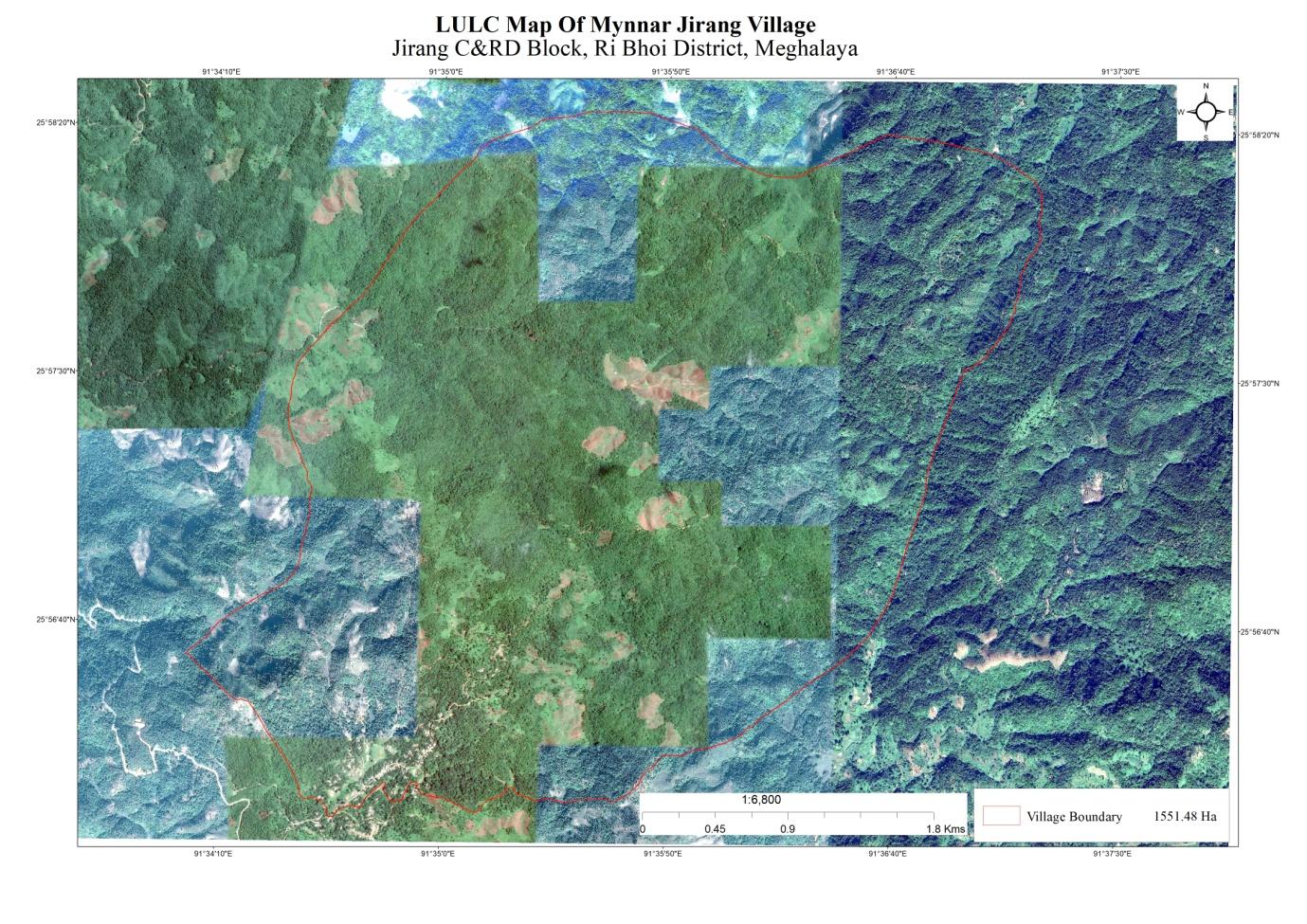
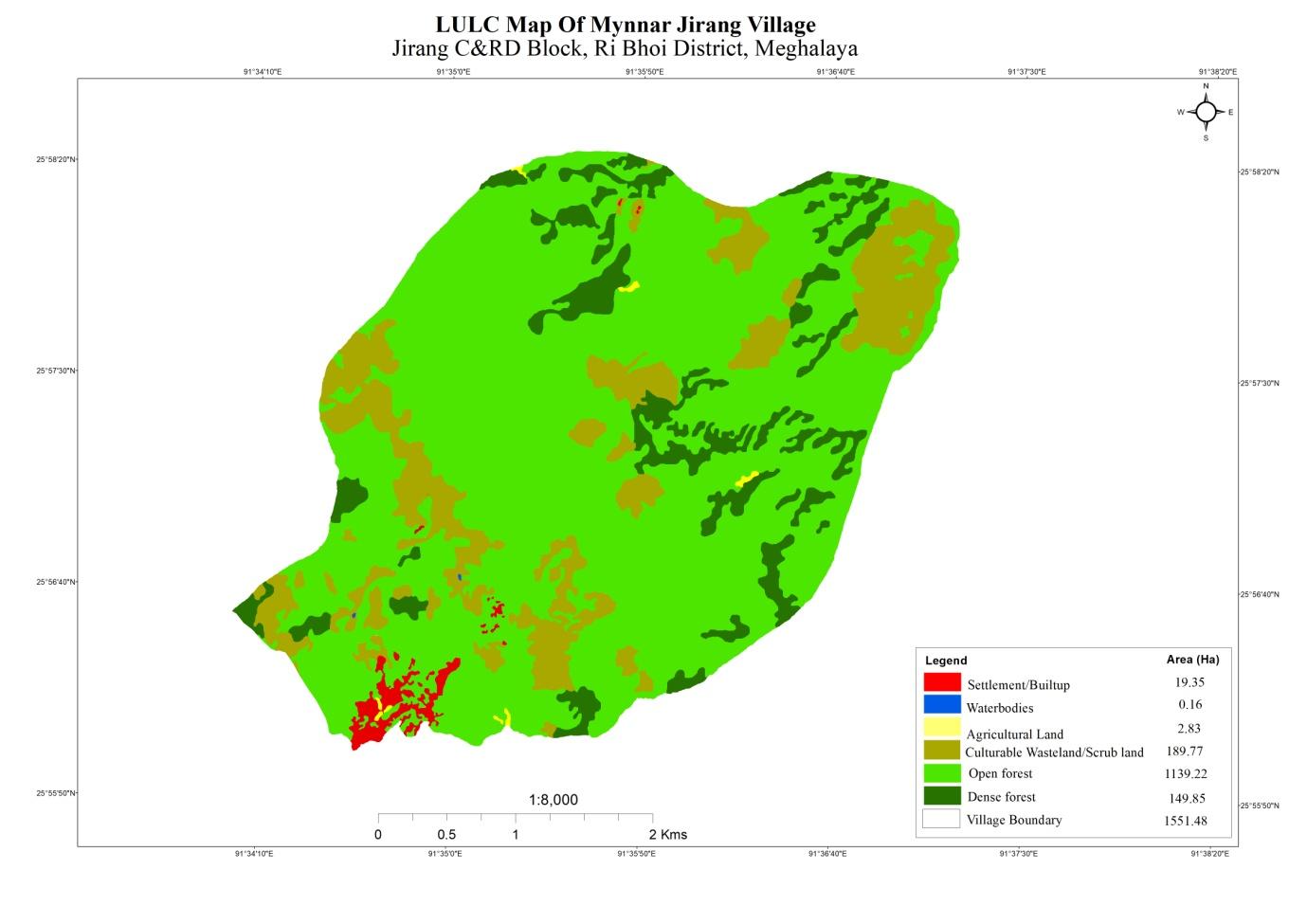
PROJECT IMPLEMENTATION
| NAME OF THE INTERVENTION | SITE NAME | TOTAL AMOUNT | DATE OF COMPLETION | WORK STATUS |
|---|---|---|---|---|
| CHECK DAM | UM SHANGYIUR | 1,95,330 | 10.12.2019 | COMPLETED |
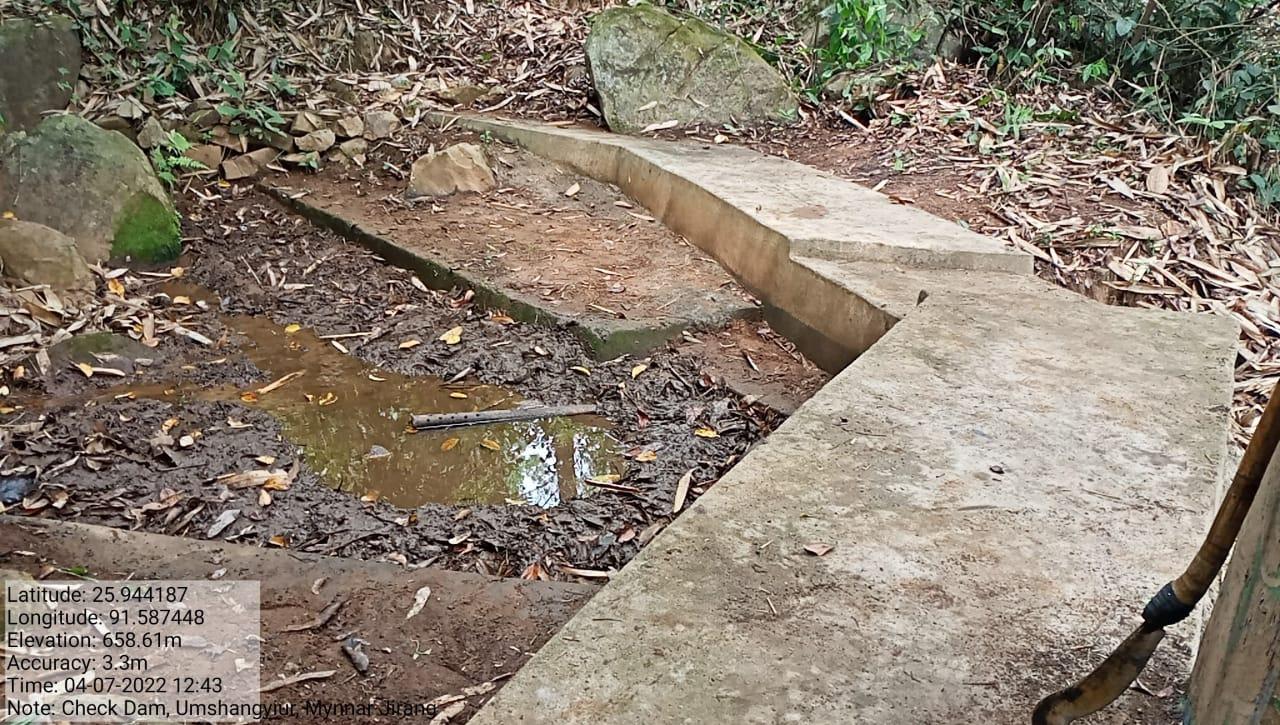
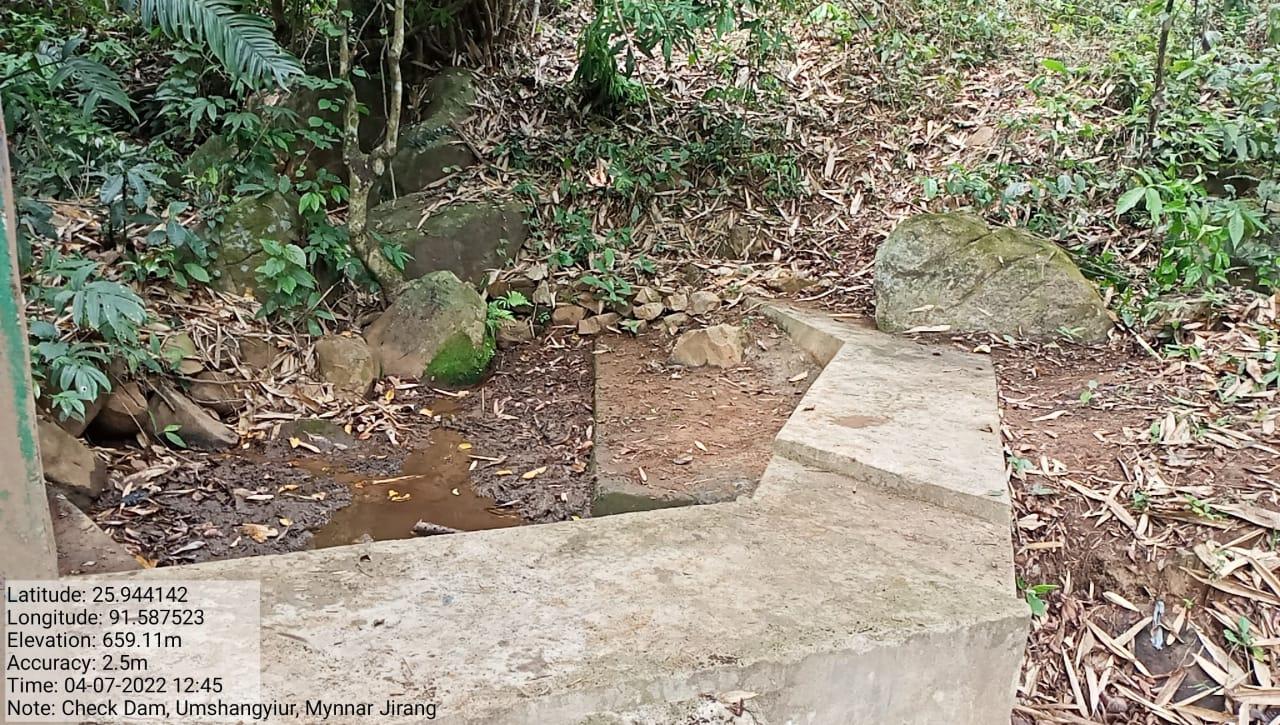
| NAME OF THE INTERVENTION | SITE NAME | TOTAL AMOUNT | DATE OF COMPLETION | WORK STATUS |
|---|---|---|---|---|
CONTOUR TRENCH CONTOUR TRENCH(2) |
LUM UM SHANGYIUR AMPAMBAH |
66,320 1,16,060 |
29.12.2019 4.11.2021 |
COMPLTED COMPLETED |
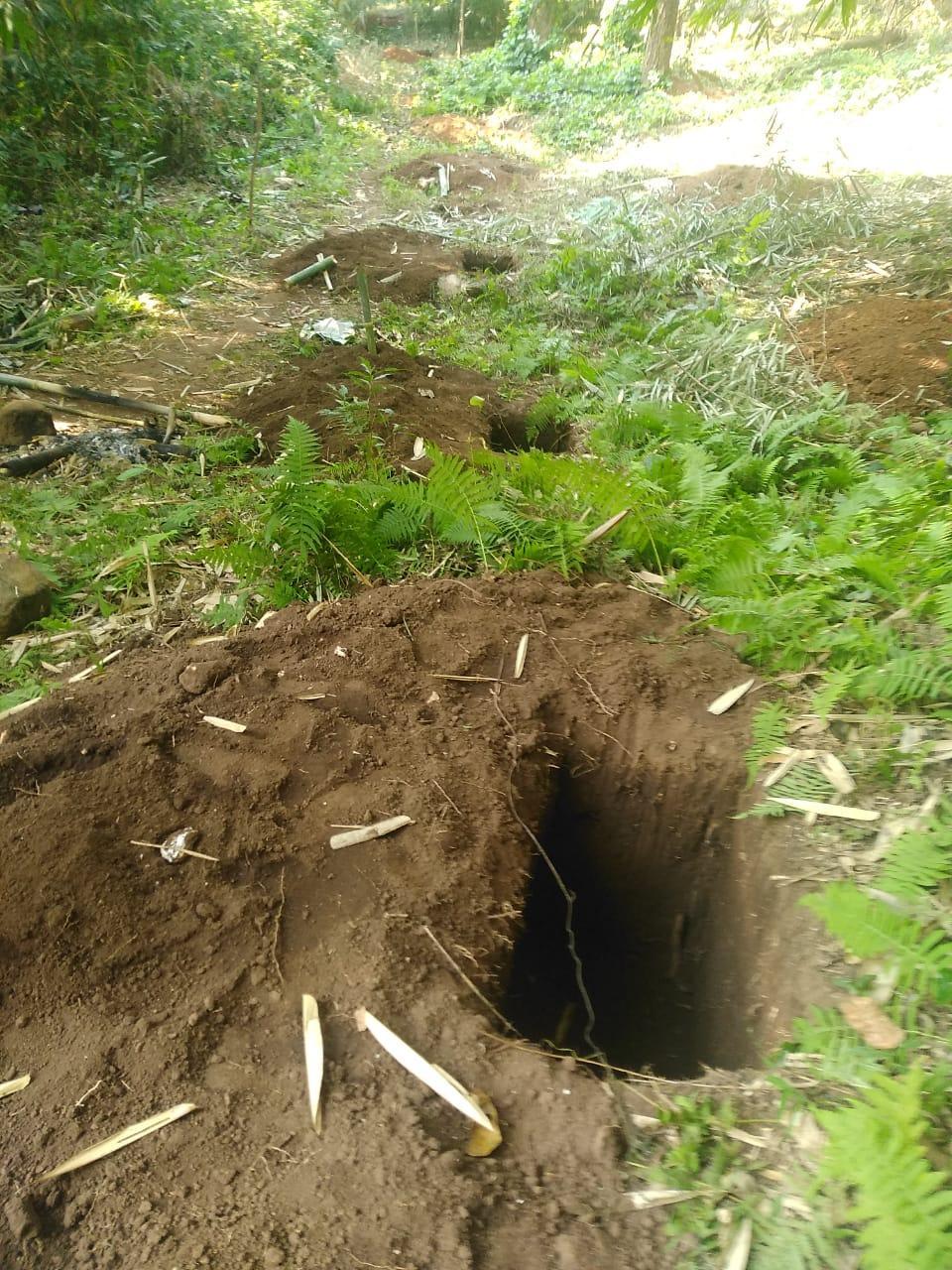
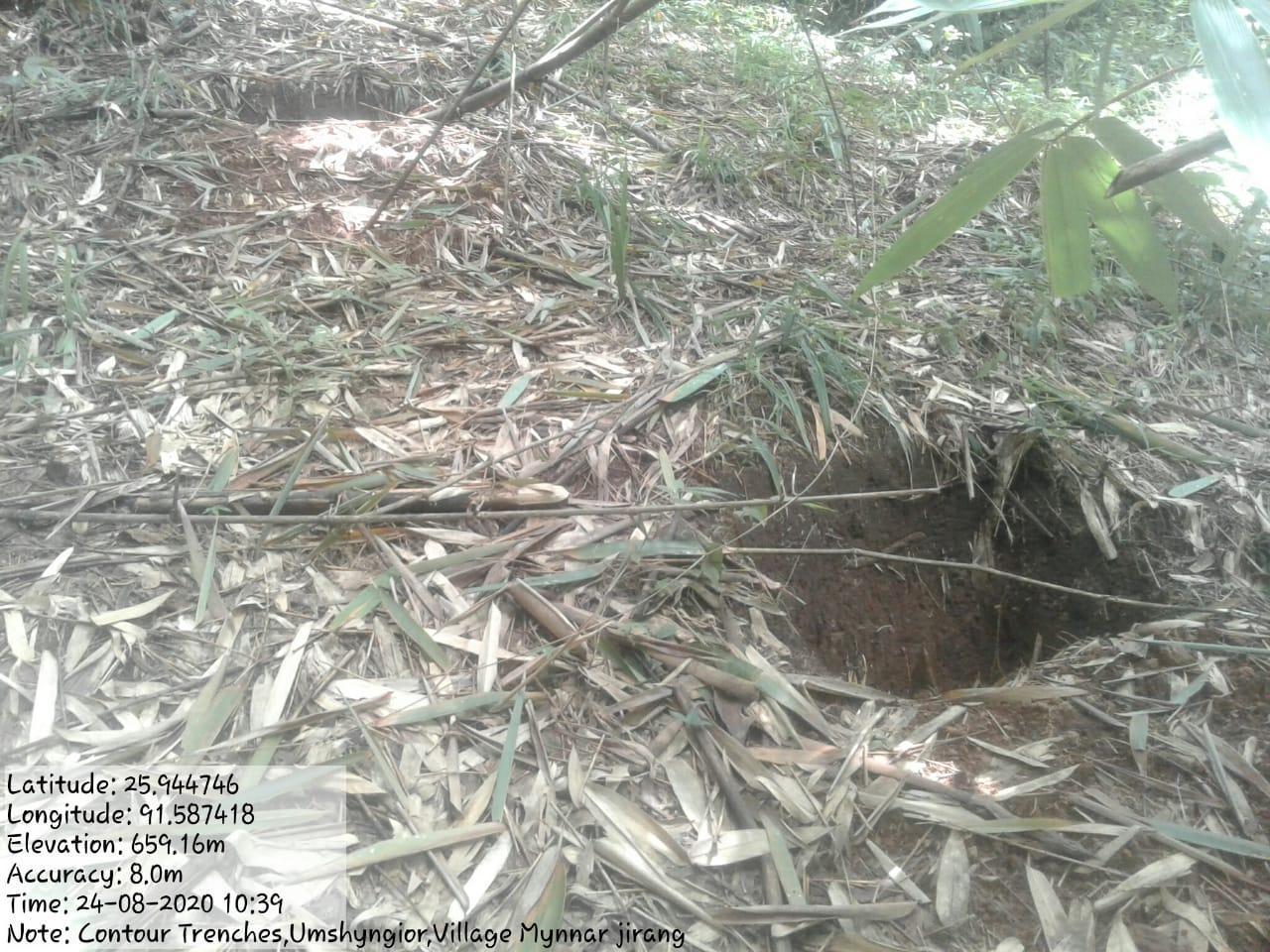
| NAME OF THE INTERVENTION | SITE NAME | TOTAL AMOUNT | DATE OF COMPLETION | WORK STATUS |
|---|---|---|---|---|
| FOREST FIRE LINE | PAREI SOHRIAT | 92,500 | 18.03.2020 | COMPLETED |
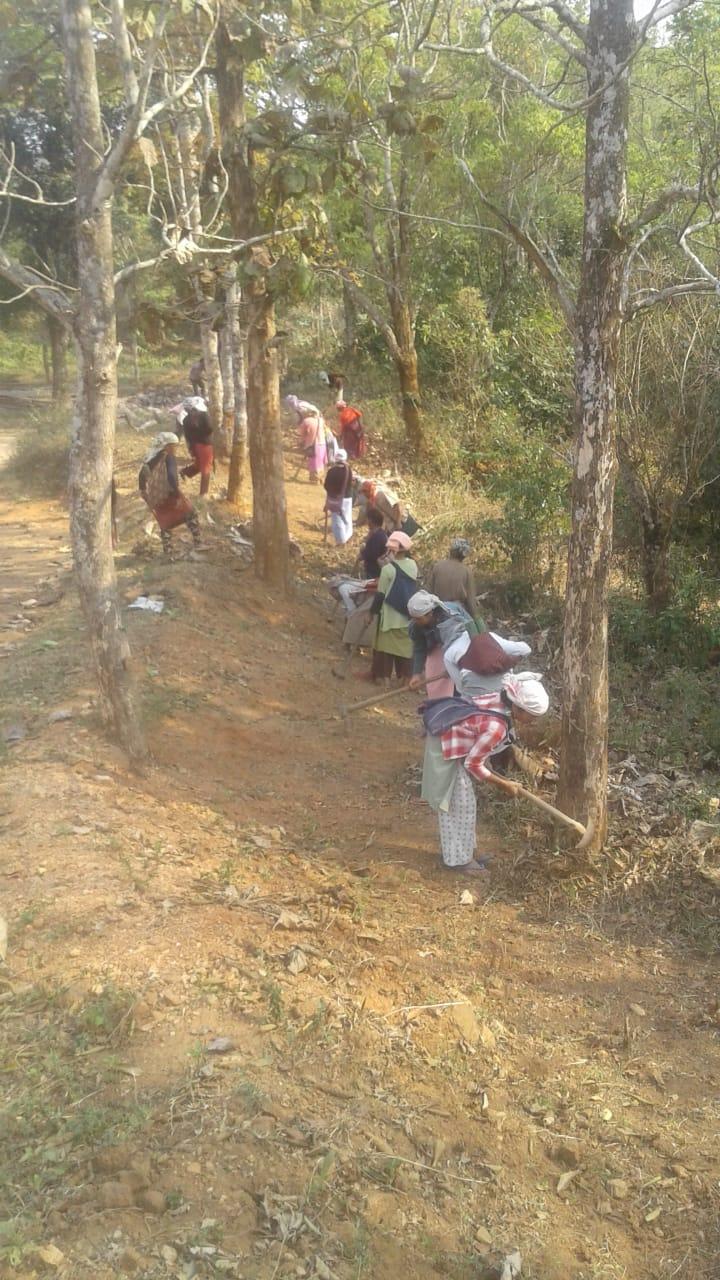
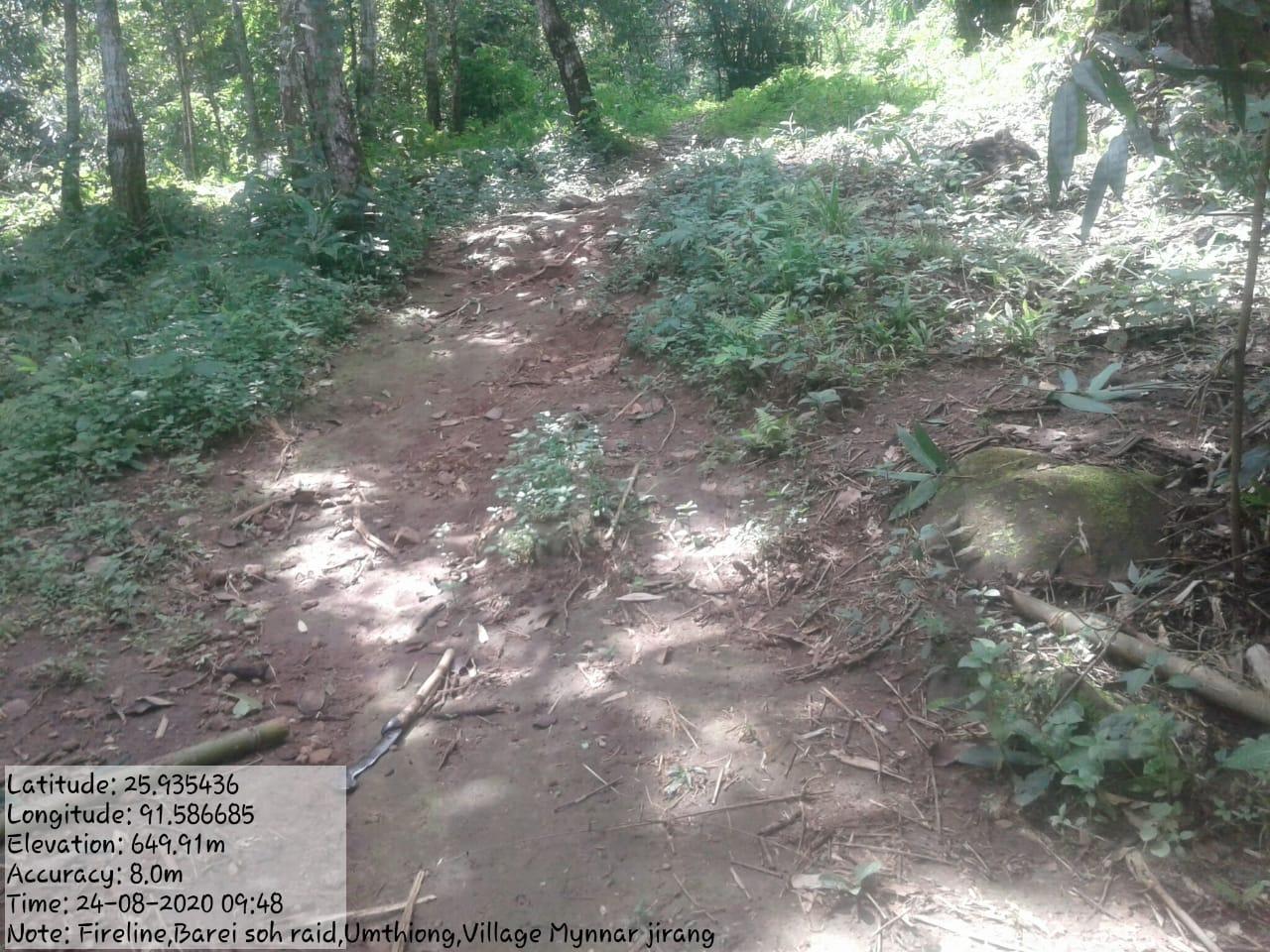
| NAME OF THE INTERVENTION | SITE NAME | TOTAL AMOUNT | DATE OF COMPLETION | WORK STATUS |
|---|---|---|---|---|
| DESILTATION | AMBUMBAH | 36,540 | 20.07.2020 | COMPLETED |
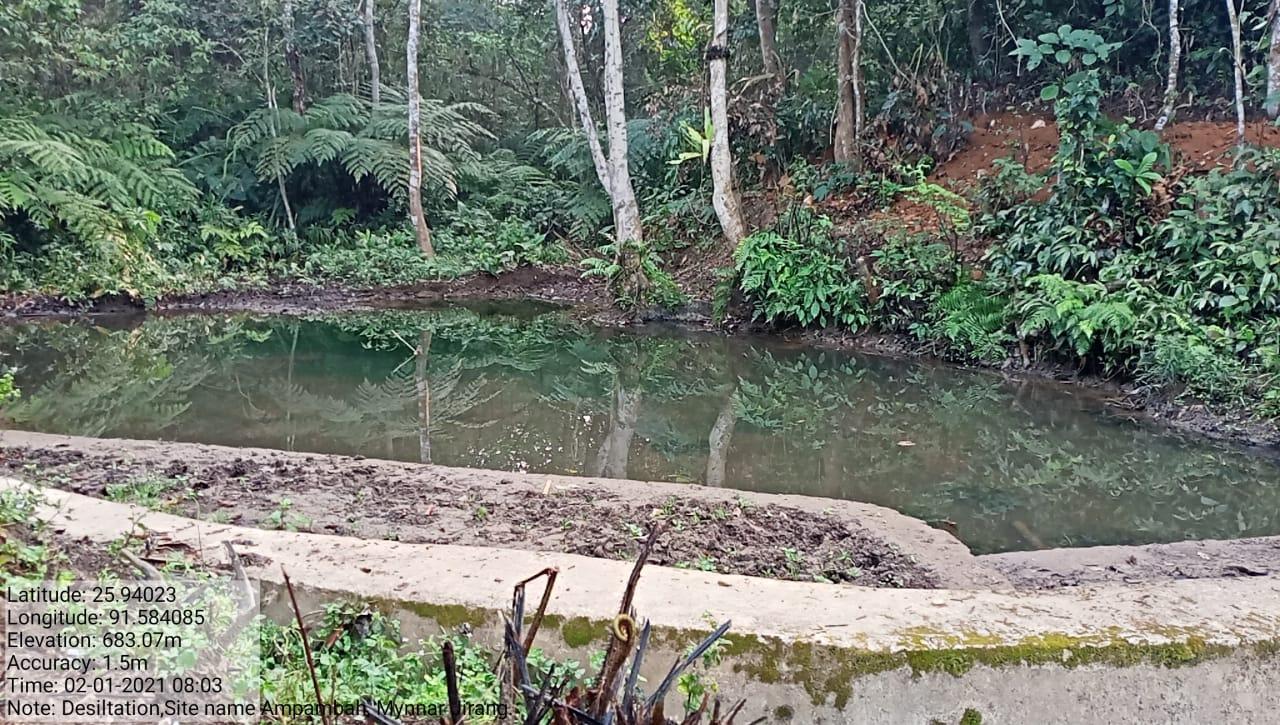
| NAME OF THE INTERVENTION | SITE NAME | TOTAL AMOUNT | DATE OF COMPLETION | WORK STATUS |
|---|---|---|---|---|
| NURSERY | UMSKOW | 1,19,300 | 14.07.2020 | COMPLETED |
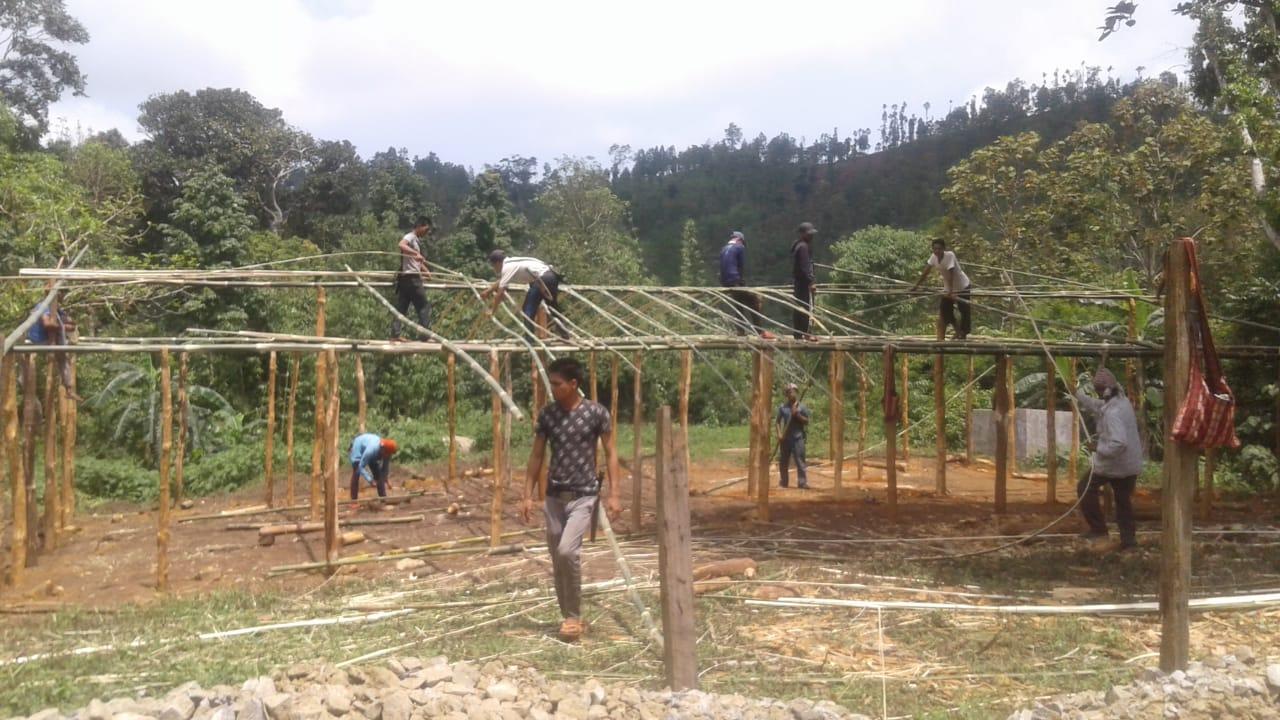
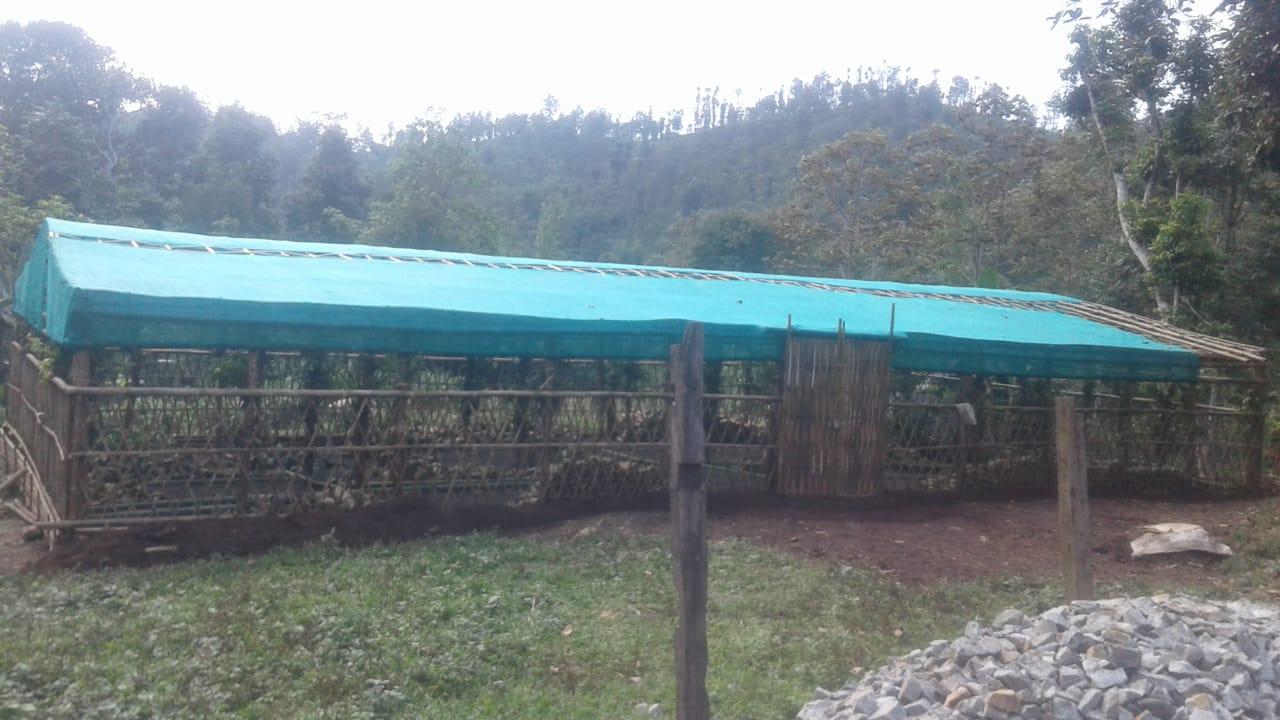
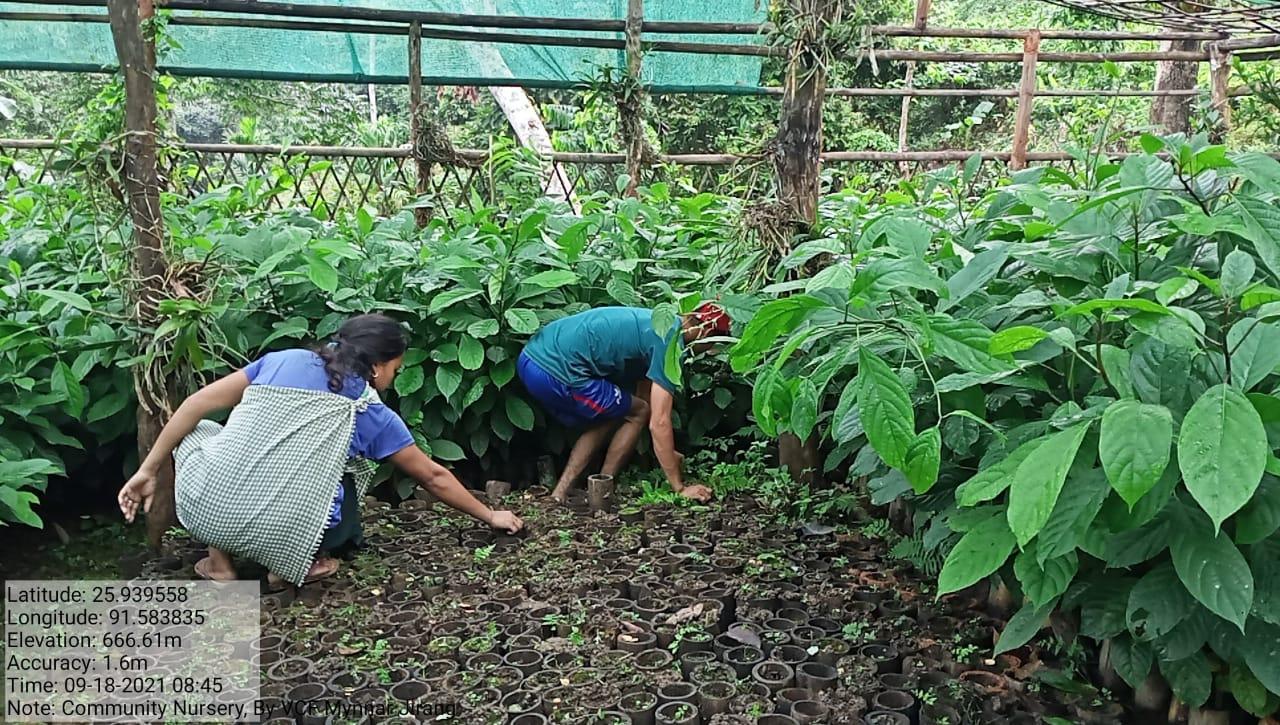
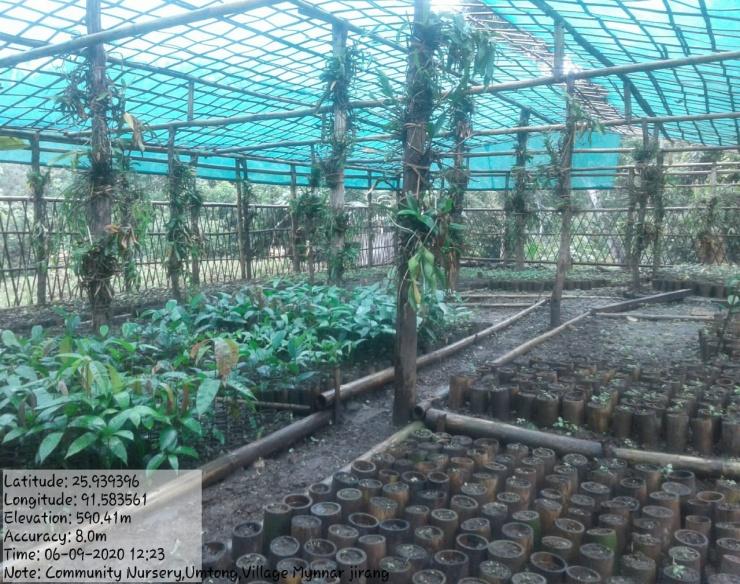
| NAME OF THE INTERVENTION | SITE NAME | TOTAL AMOUNT | DATE OF COMPLETION | WORK STATUS |
|---|---|---|---|---|
| AFFORESTATION | AMHLI AMPHUNG | 5,69,720 | 29.07.2020 | COMPLETED |
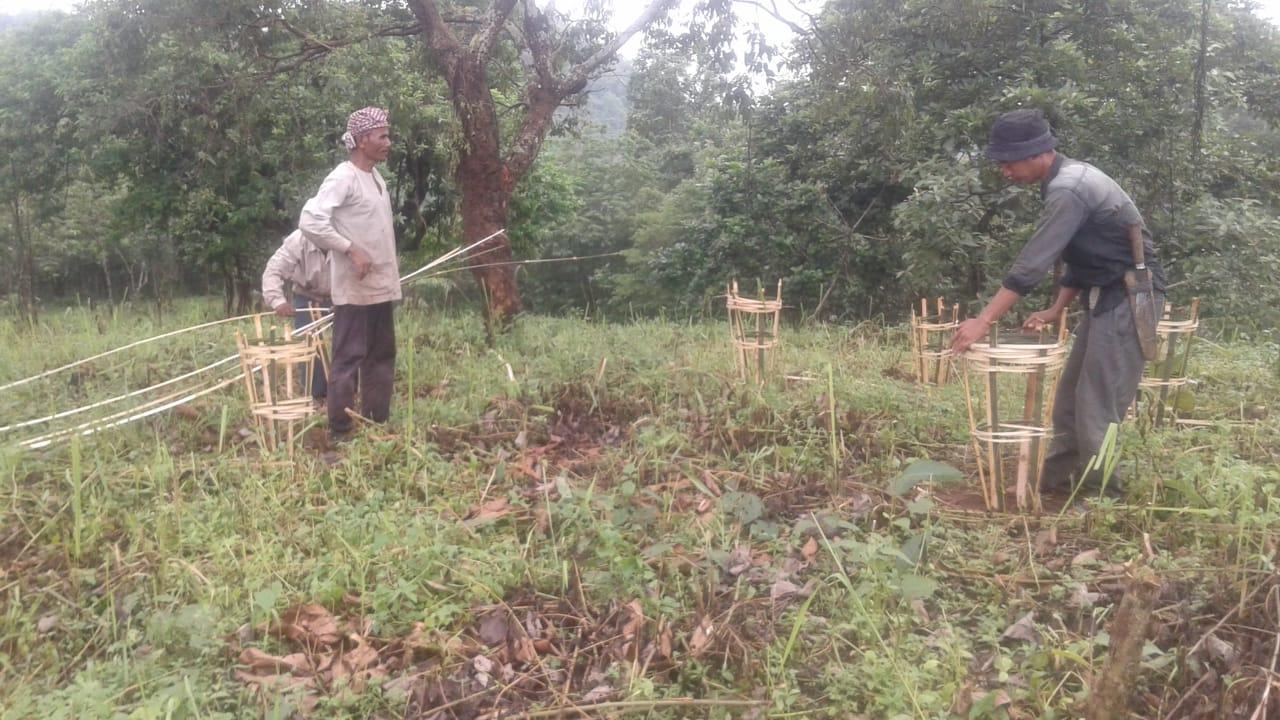
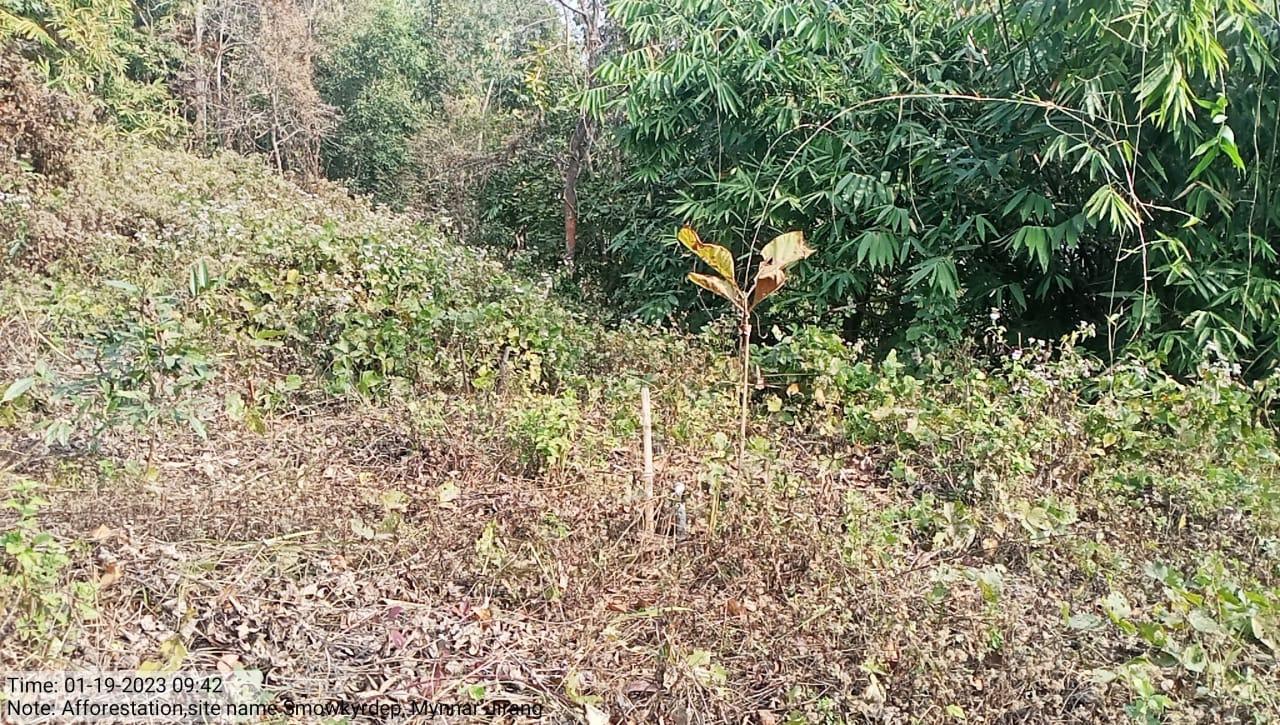

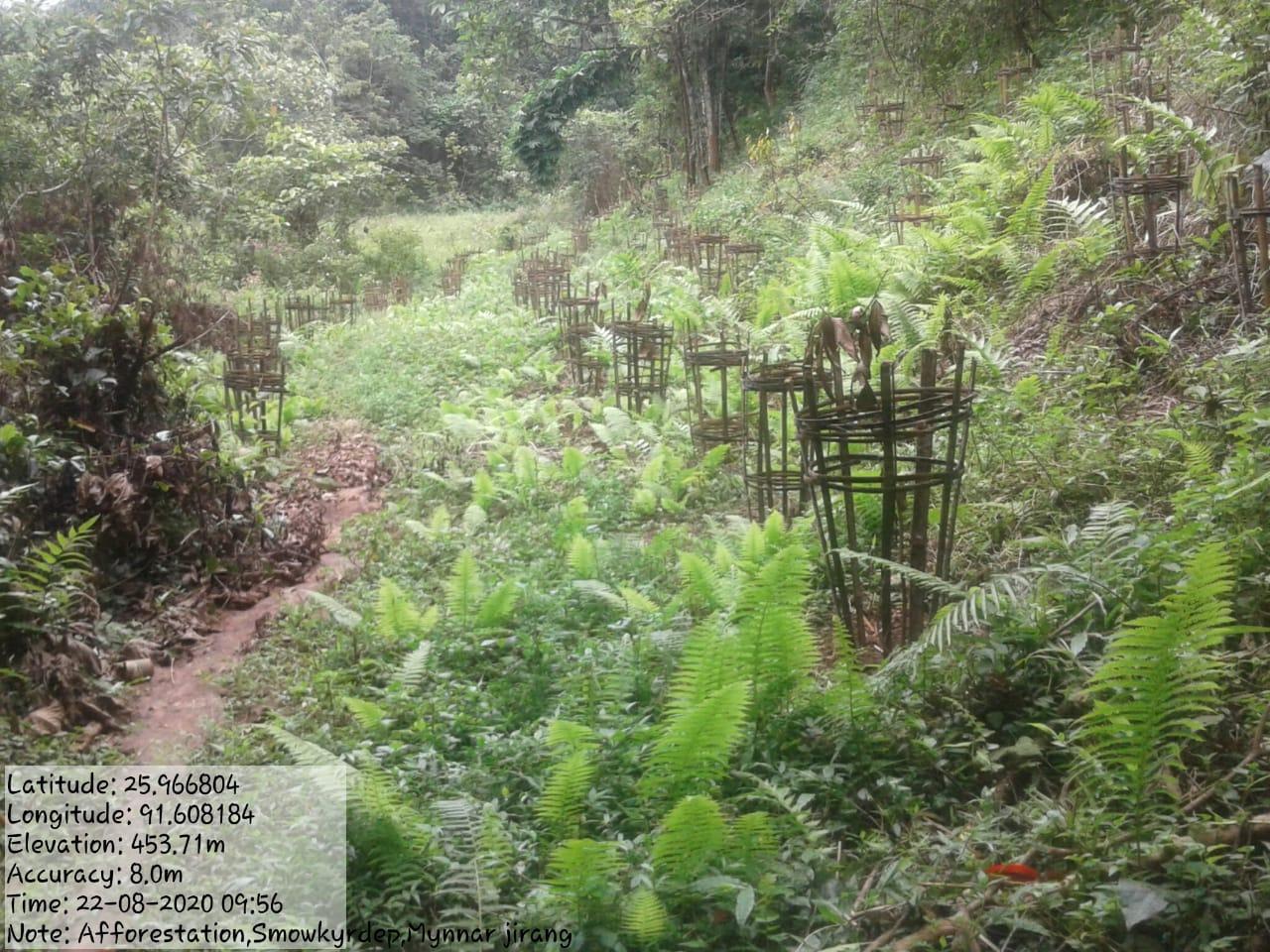
| NAME OF THE INTERVENTION | SITE NAME | TOTAL AMOUNT | DATE OF COMPLETION | WORK STATUS |
|---|---|---|---|---|
| BENCH TERRACING | PALIAR | 2,99,300 | 15.09.2020 | COMPLETED |
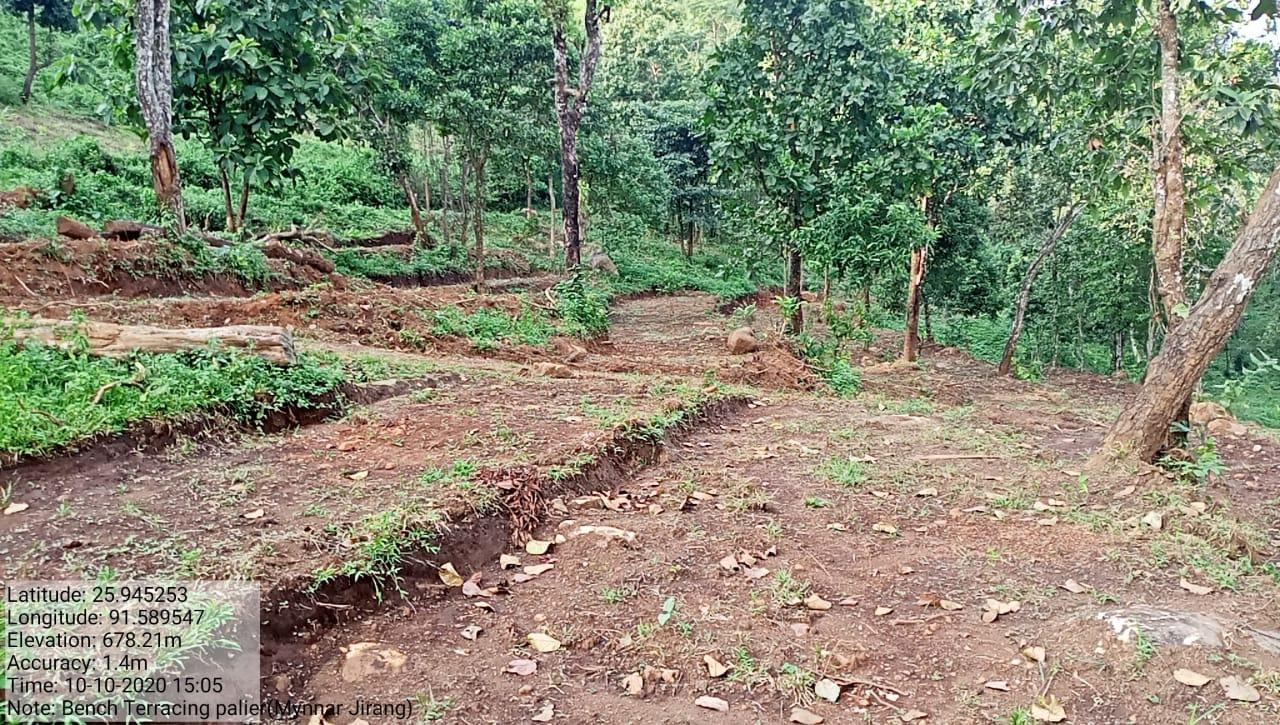



| NAME OF THE INTERVENTION | SITE NAME | TOTAL AMOUNT | DATE OF COMPLETION | WORK STATUS |
|---|---|---|---|---|
| VERMI COMPOSTING(10 UNITS) | PREIIO | 3,32,460 | 25.11.2020 | COMPLETED |

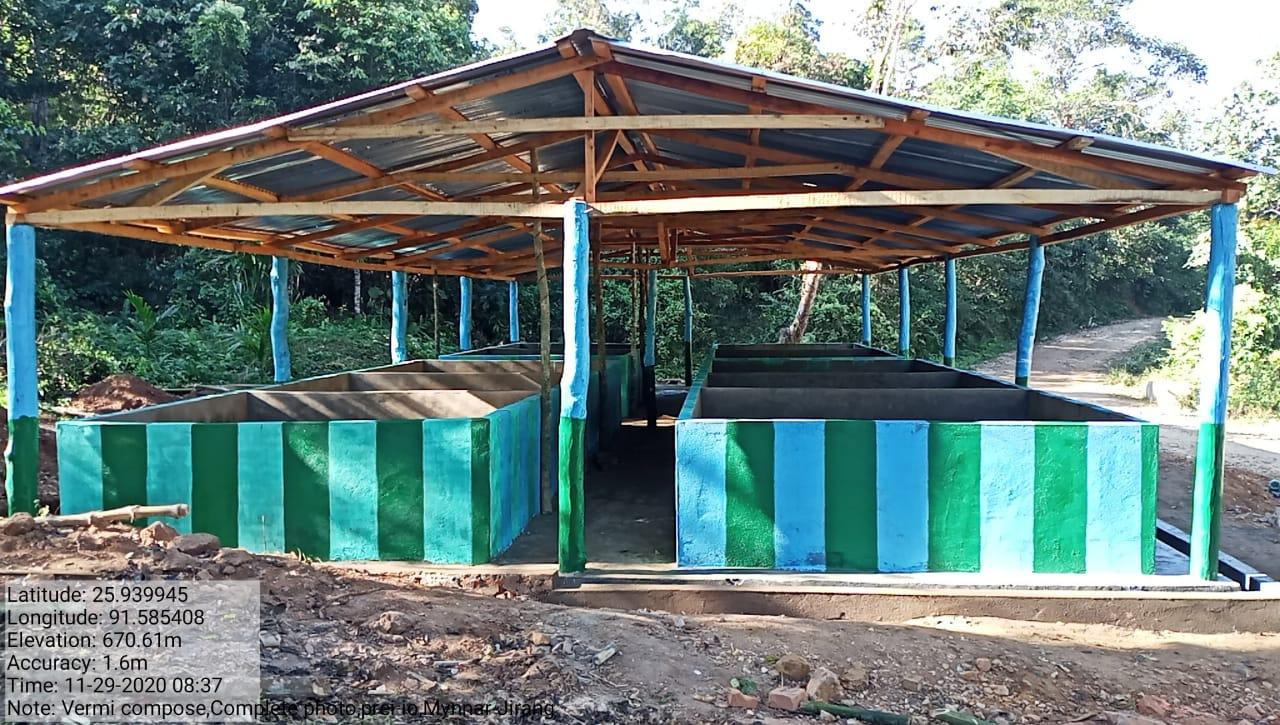
| NAME OF THE INTERVENTION | SITE NAME | TOTAL AMOUNT | DATE OF COMPLETION | WORK STATUS |
|---|---|---|---|---|
| SPRING CHAMBER | AMSHOINA | 66,000 | 23.12.2020 | COMPLETED |



| NAME OF THE INTERVENTION | SITE NAME | TOTAL AMOUNT | DATE OF COMPLETION | WORK STATUS |
|---|---|---|---|---|
| LOOSE BOULDER BUND | AMPAMBAH | 1,09,100 | 26.03.2021 | COMPLETED |
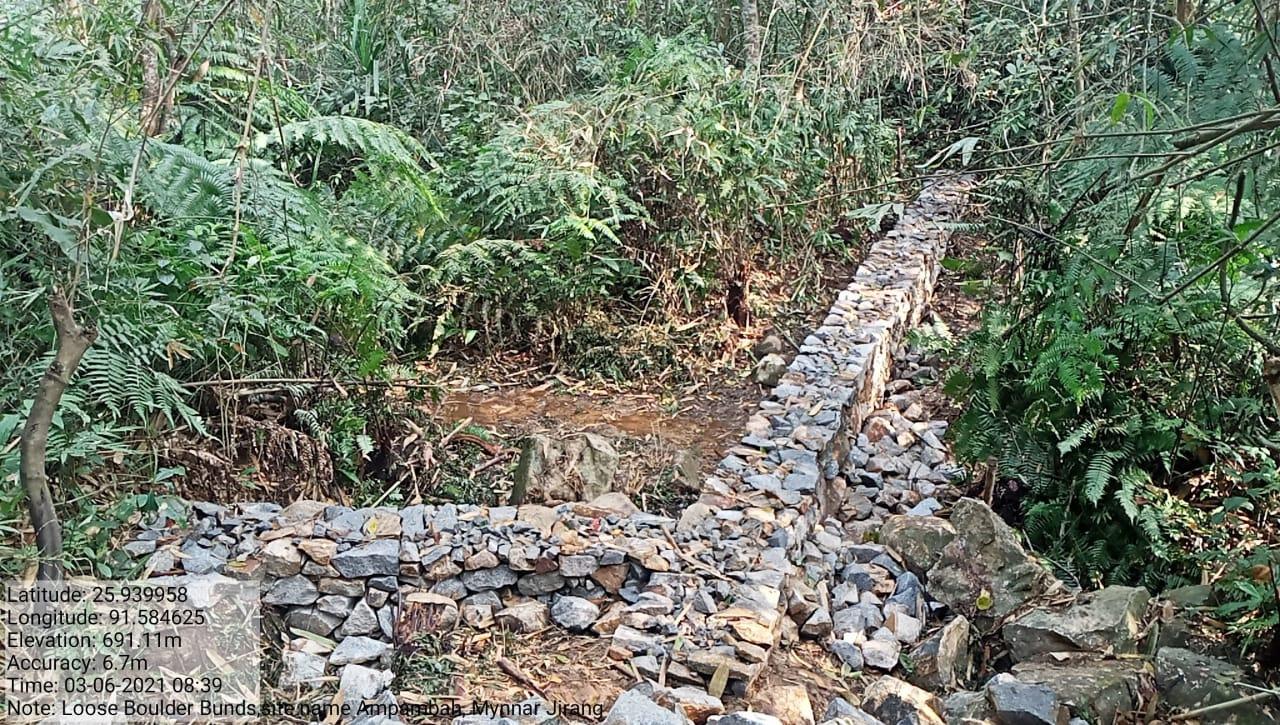
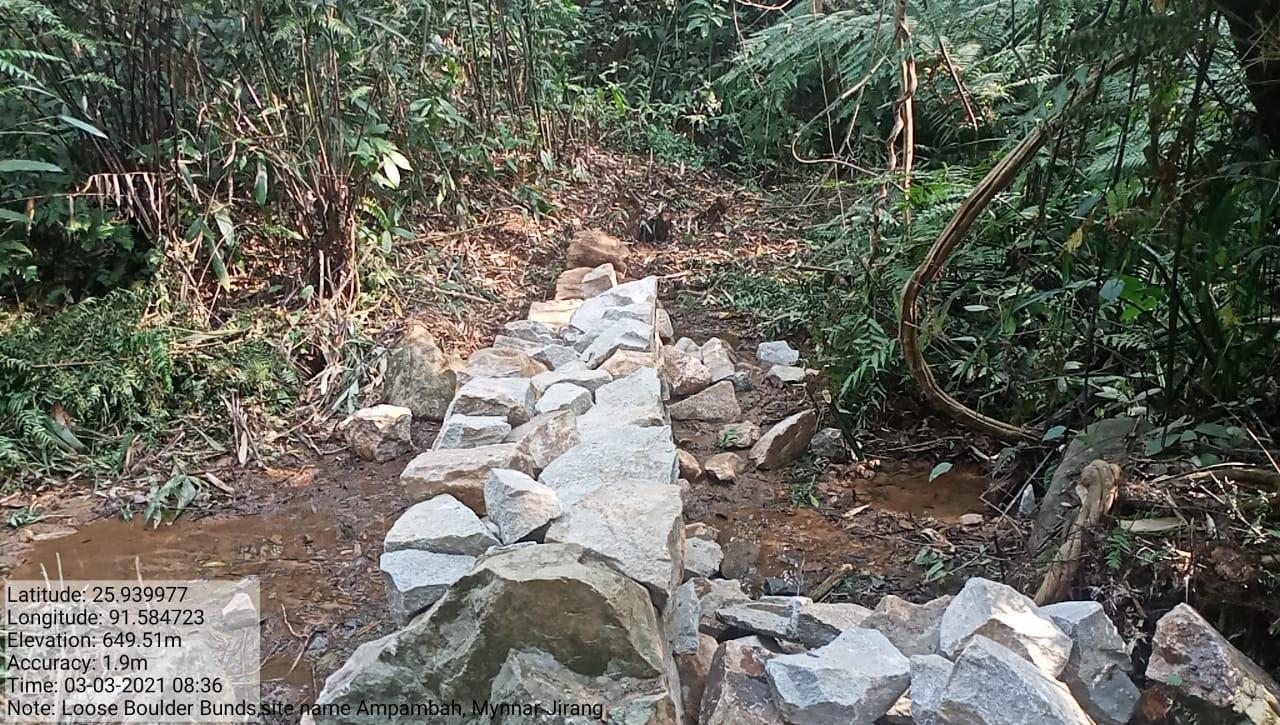
| NAME OF THE INTERVENTION | SITE NAME | TOTAL AMOUNT | DATE OF COMPLETION | WORK STATUS |
|---|---|---|---|---|
| EARTHEN BUNDS | AMPAMBAH | 1,52,370 | 28.04.2021 | COMPLETED |
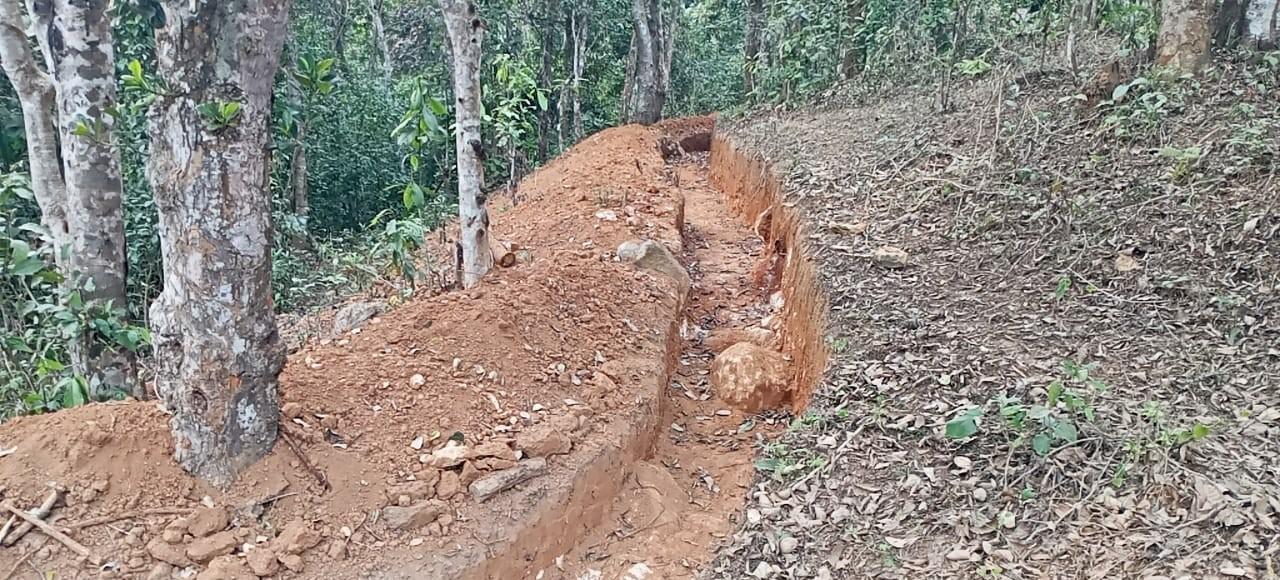
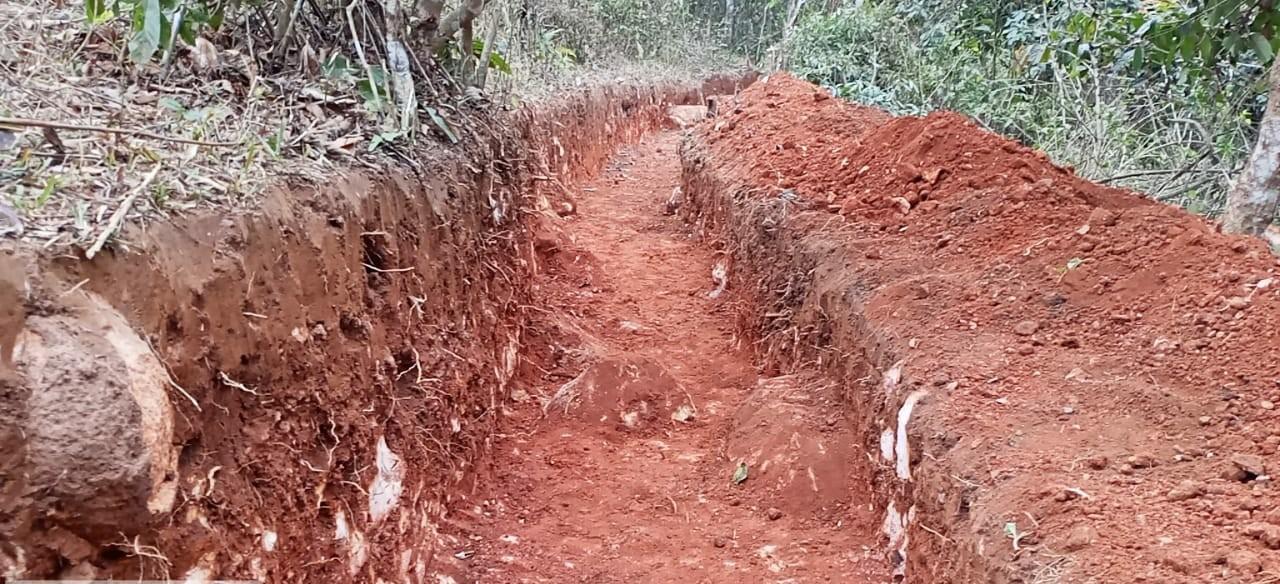
| NAME OF THE INTERVENTION | SITE NAME | TOTAL AMOUNT | DATE OF COMPLETION | WORK STATUS |
|---|---|---|---|---|
FMP Activities Fire Control Line Enrichment planting in forest blanks Community Forest Boundary Survey Assisted Natural Regeneration in Open Forests (Contour Bund) In-situ & Ex-situ conservation of rare and endangered plants Nursery for Food Forestry (Sapling for the Existing Nursery) |
322273 180029 8000 455692 18000 11000 |
September, 2023 | COMPLETED |
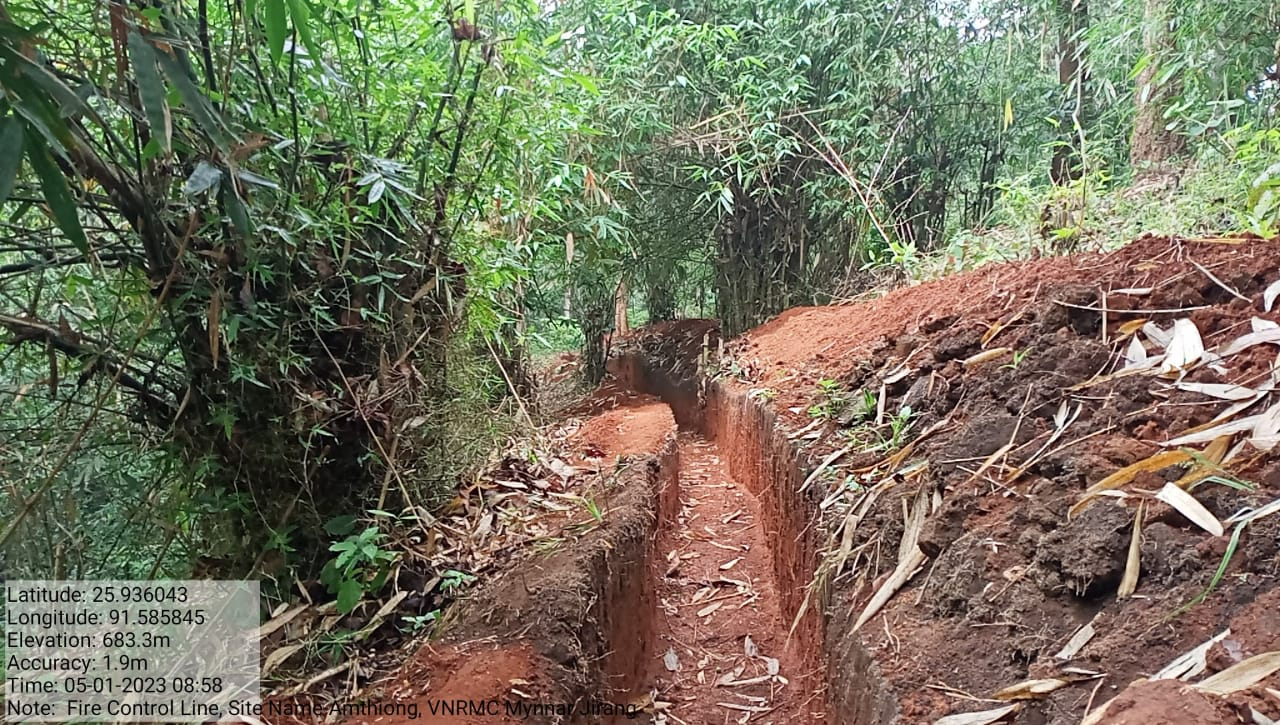
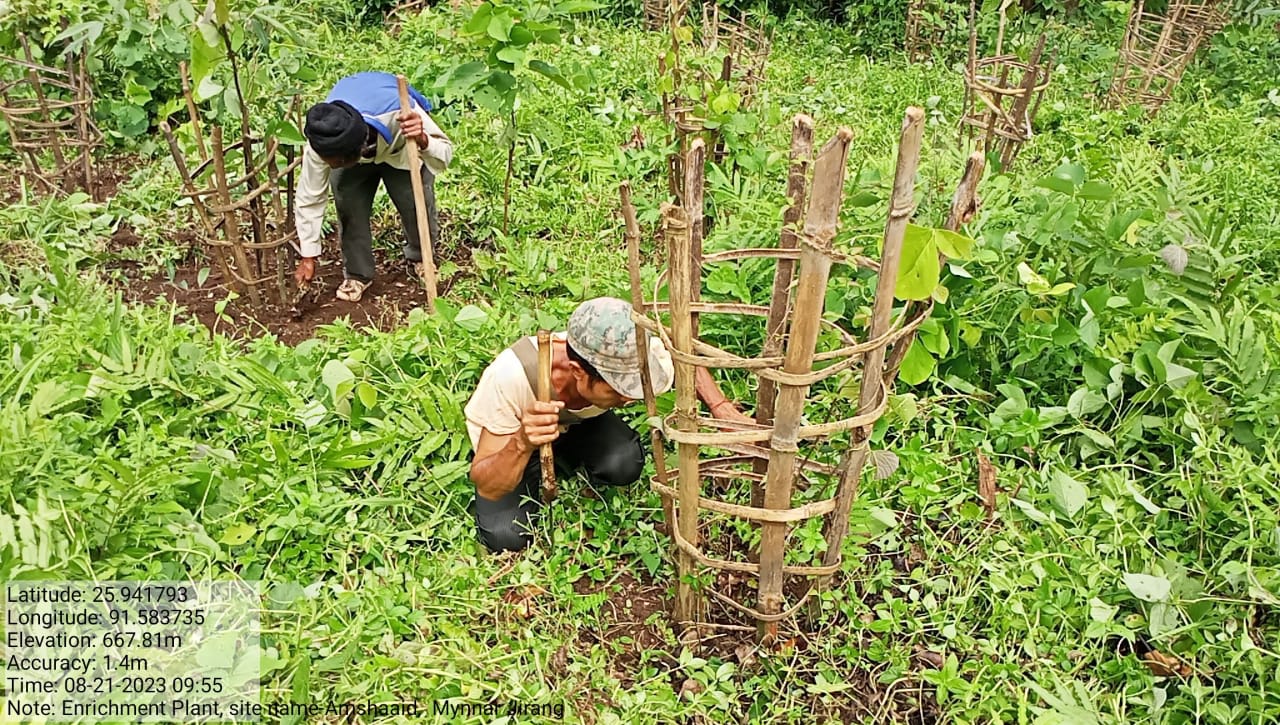
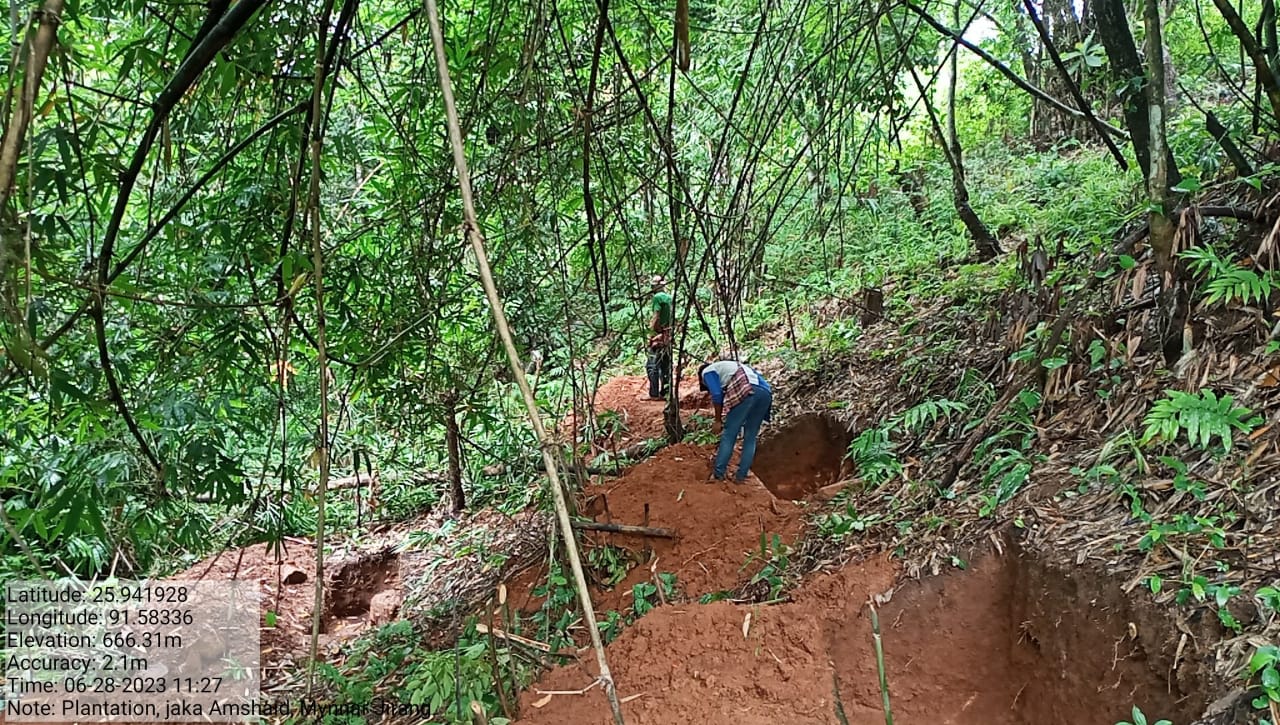
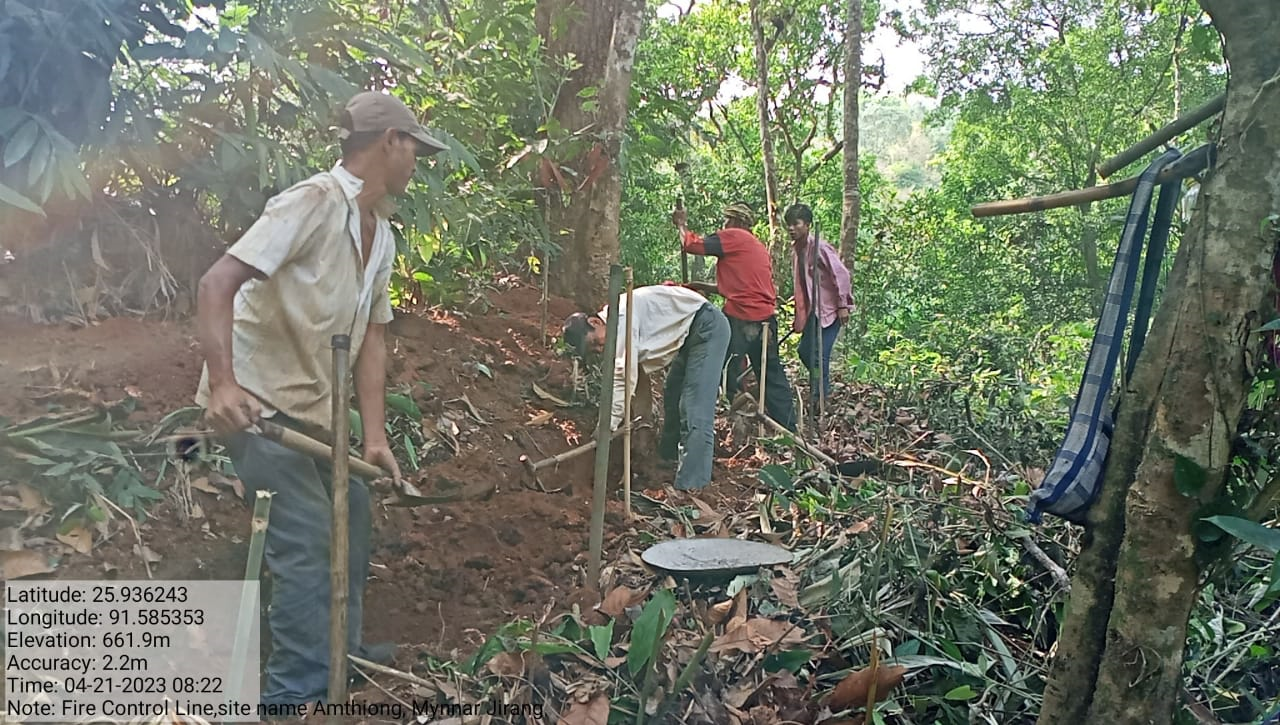
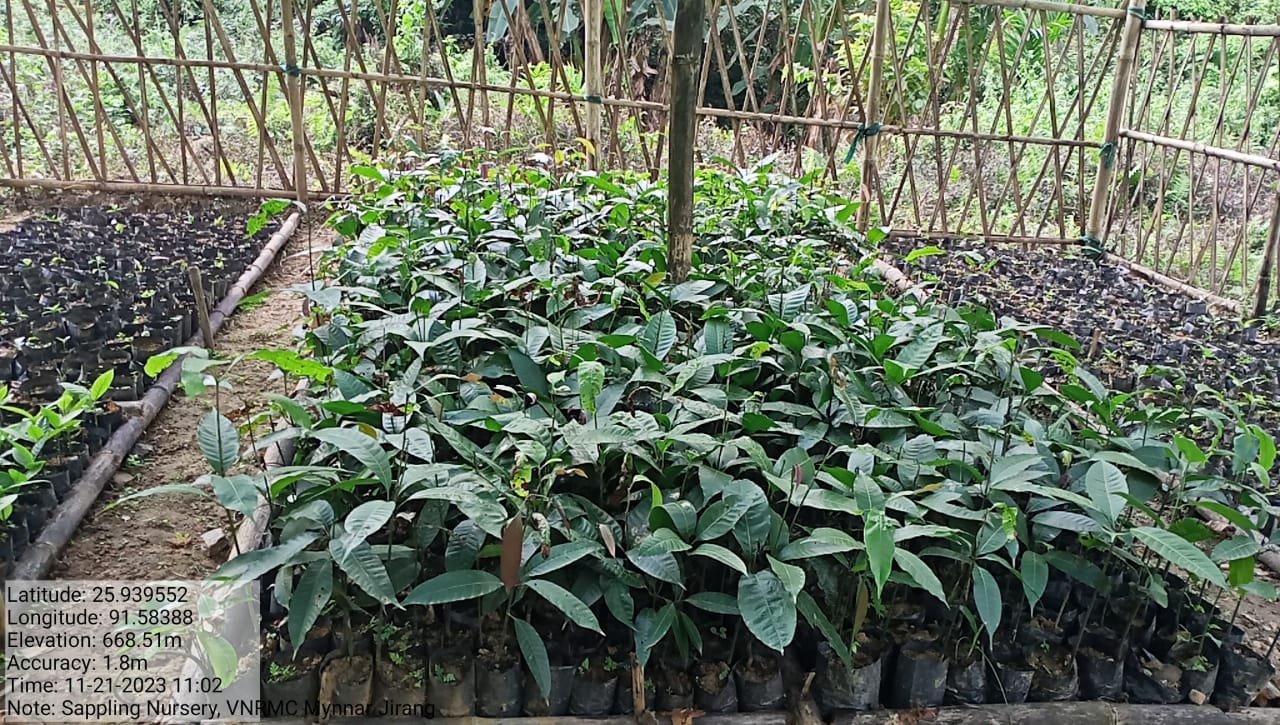
| Intervention | Site Name | Amount | Work Status |
|---|---|---|---|
Excess fund activities PA System Water tester Gates for Spring Chamber |
community land | 86,000 | Completed |
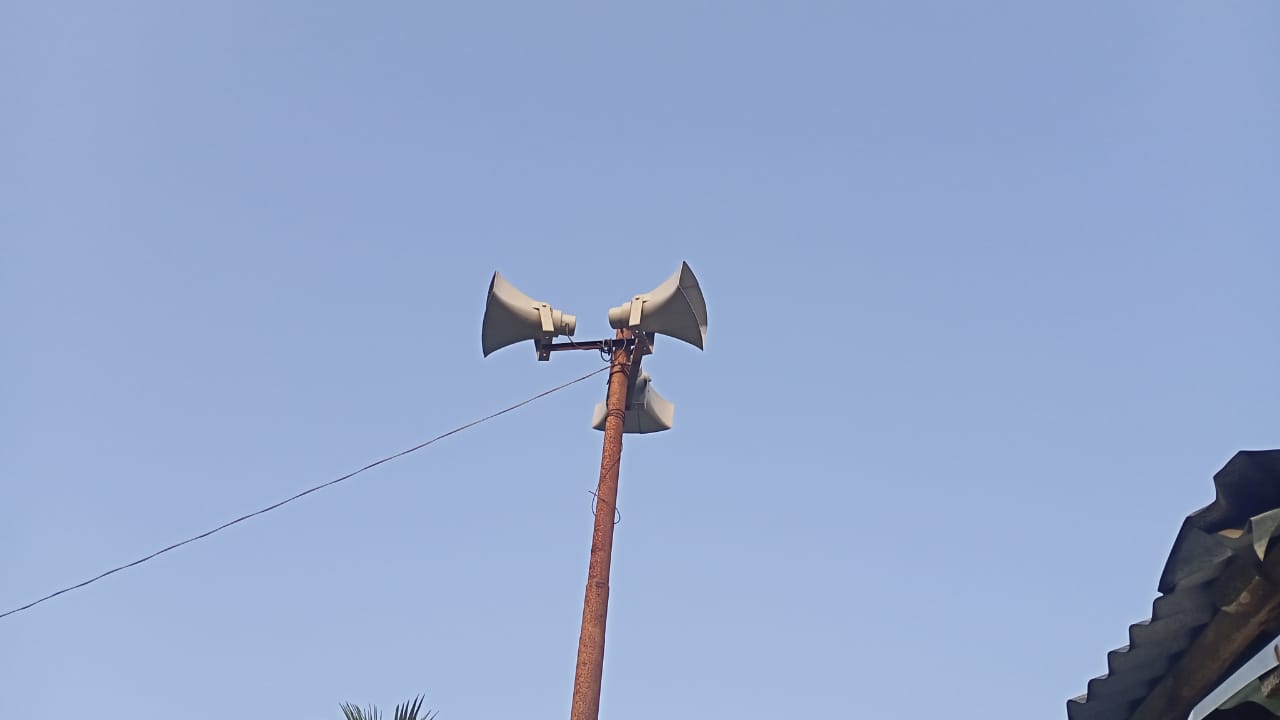
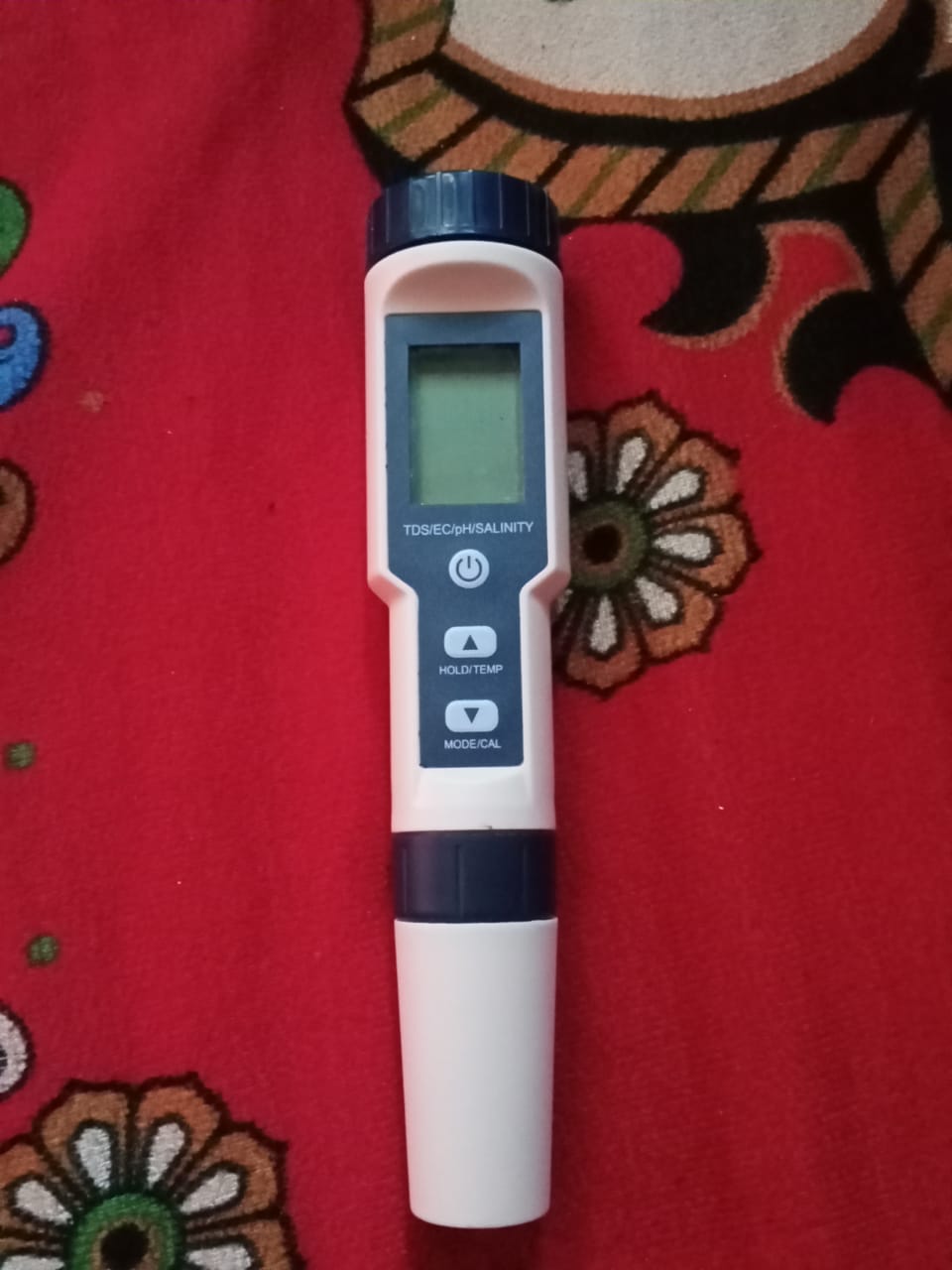
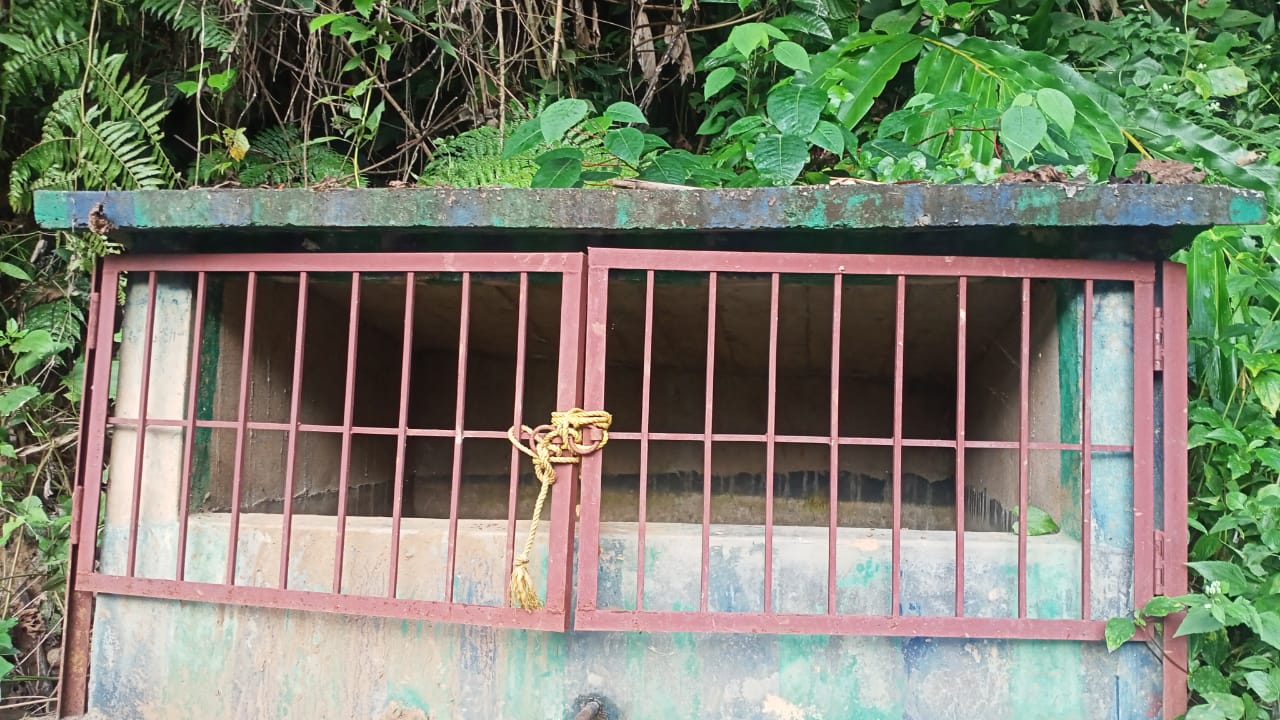
TESTIMONIALS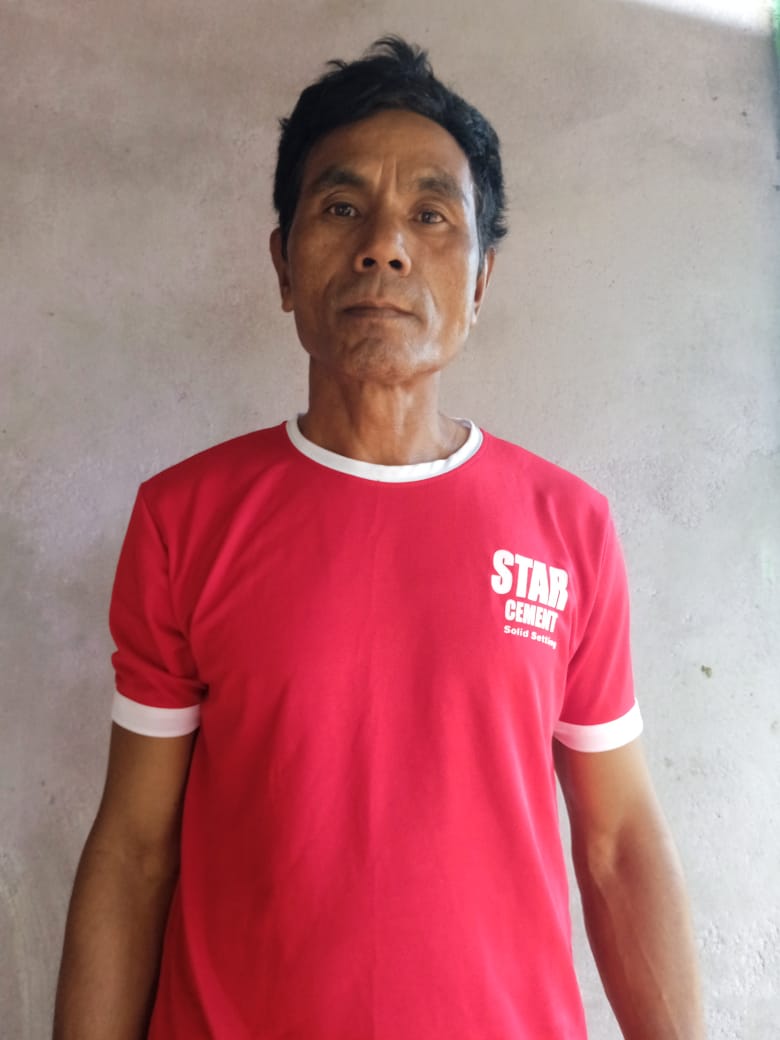
President - Arbanshan Jamer
The benefits that we got through the project are that to make the water sources better and to provide jobs to the villagers. Our village lack in terms of meeting the water requirements and our water sources were almost becoming dry but with the coming of this project there are changes and we now know how to plant trees and taking care the water sources and to know plant trees in a barren land and the villagers are getting a job and to make the village clean.
VCF M&E- Dondor Syiem
I was chosen as a VCF member in the village to look after the work which the project is implementing in the village and I'm grateful for that. The project has benefited me immensely as I now not only know about the monitoring and evaluation work but also knows how to update and make entries on the MIS app about the various work of the project. All these would not be possible without the constant guidance and training that was organised by the office from time to time.
VCF KM : Sepiarlin Syiem
I am grateful to the Project and the VNRMC for electing me as a
VCF of social management. As a facilitator of Social management, I
have to make sure that all social safeguards and aspects were
adhered to in all implementations. I get to conduct house visits in
all the households of the village, learn about their understanding
of the project and the impact that the project has in their lives.
The role has provided me with endless knowledge and learning about
the various environmental aspects of how to safeguard and work in
harmony with nature.
VCF- ENV& GIS - Lawbornstar Lapang
As a facilitator of the village in the Environmental aspect, I get to work close with nature and my engagement in this field is a never ending learning experience as I get to do spring mappings using an up to date device, collect coordinates of various interventions, how to use a GPS, to collect and provide data about various implementations, and many more .All these experiences are one that I will forever be grateful and carry with me.